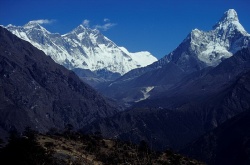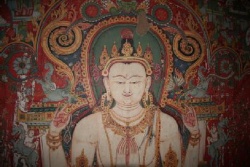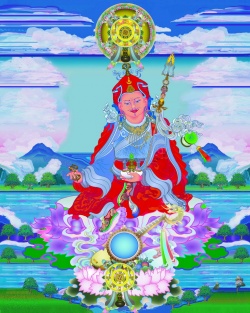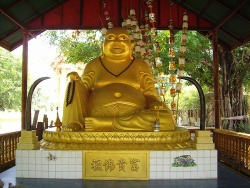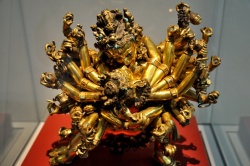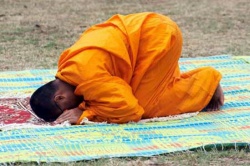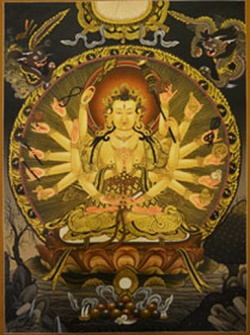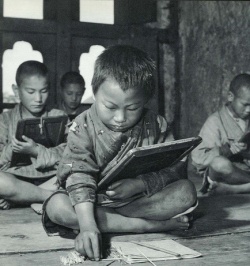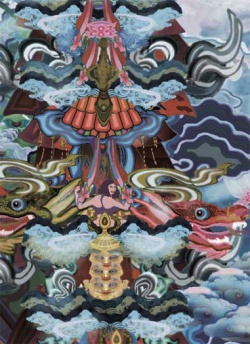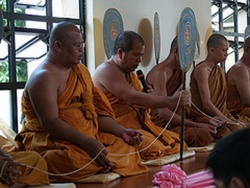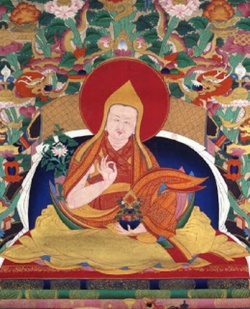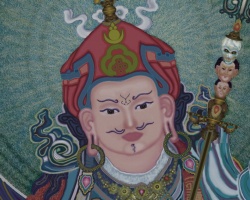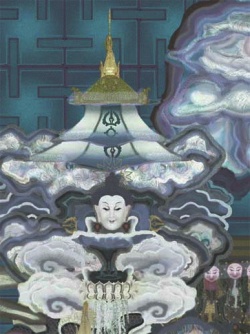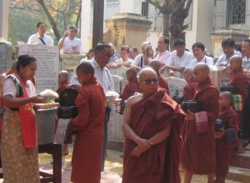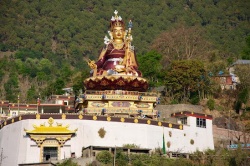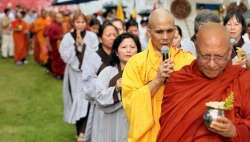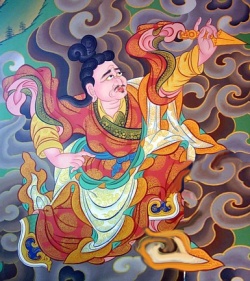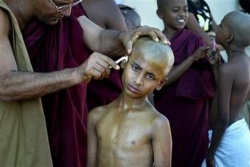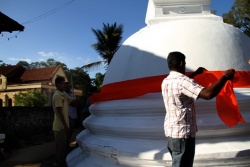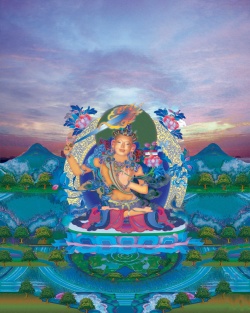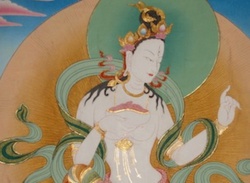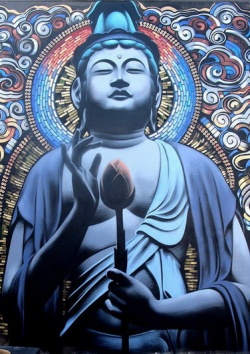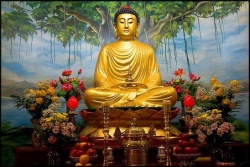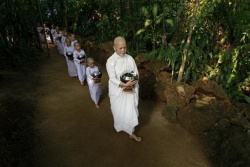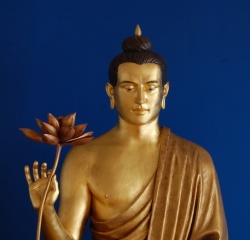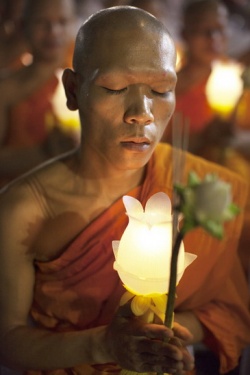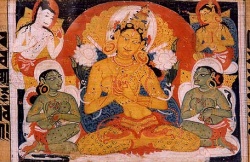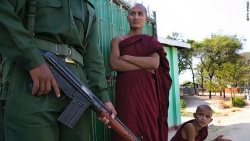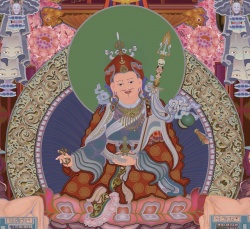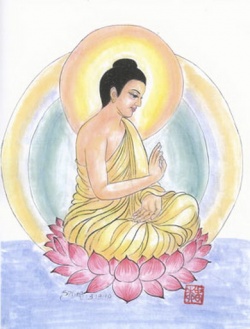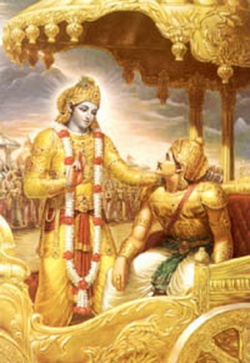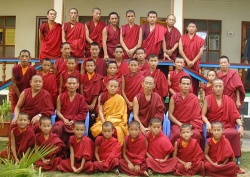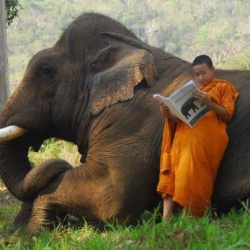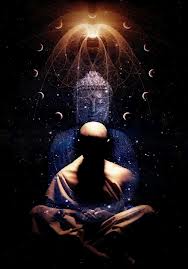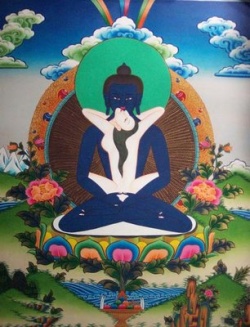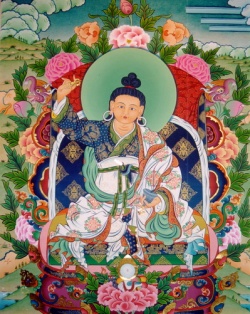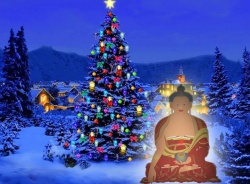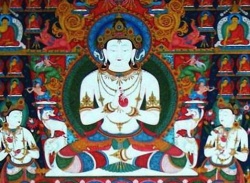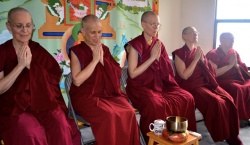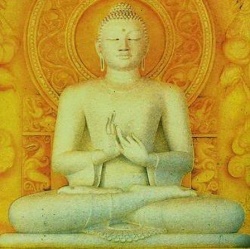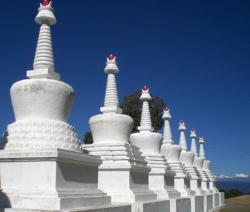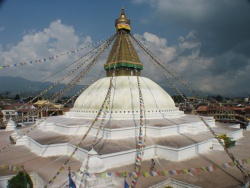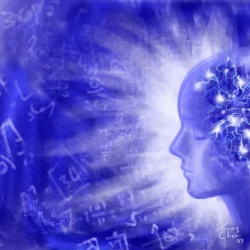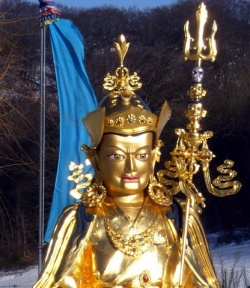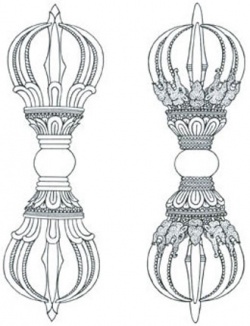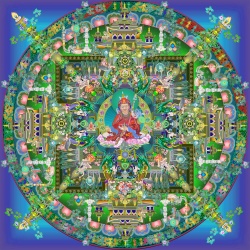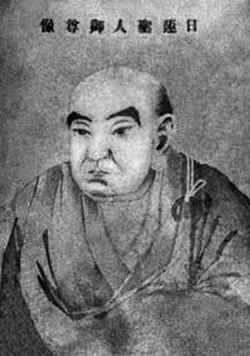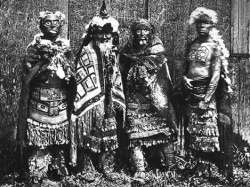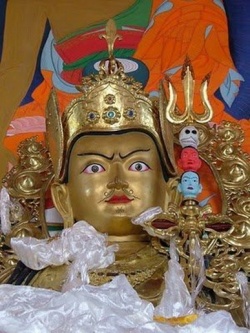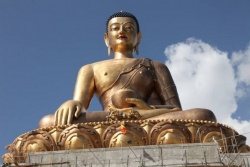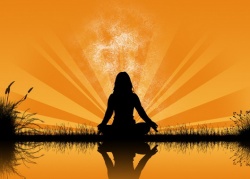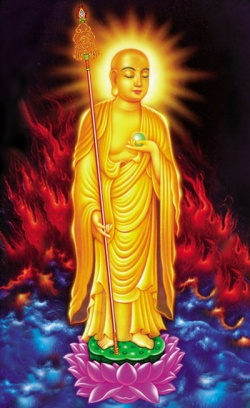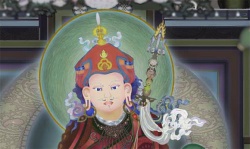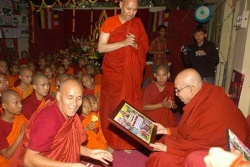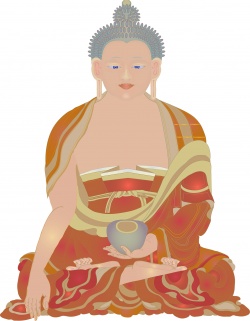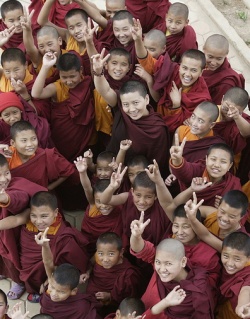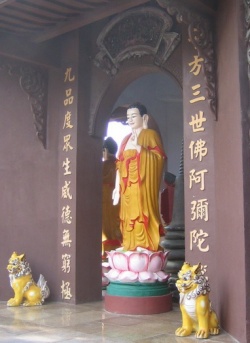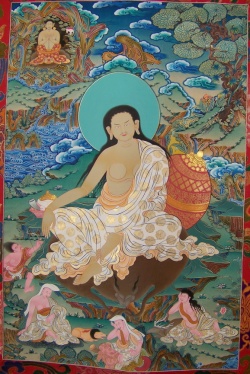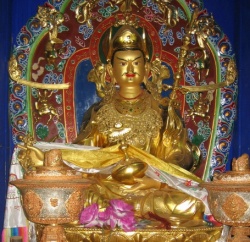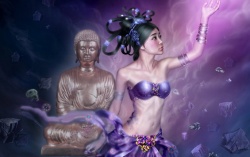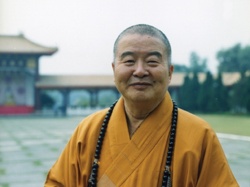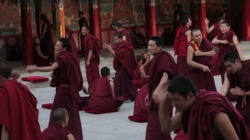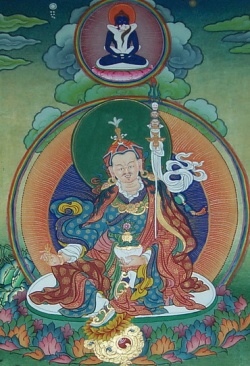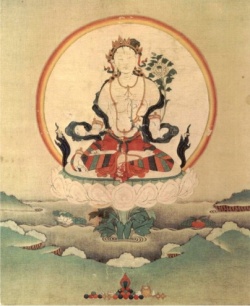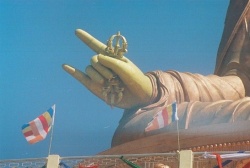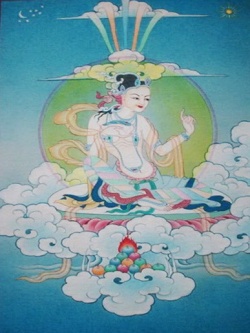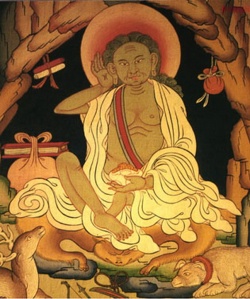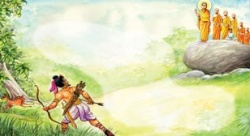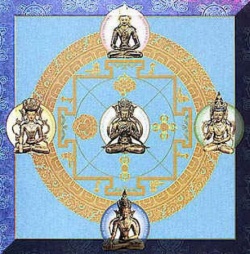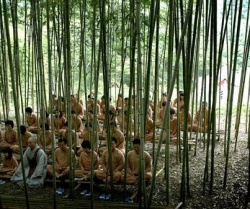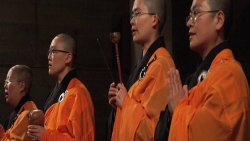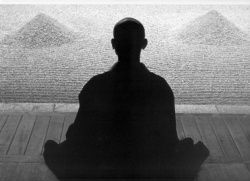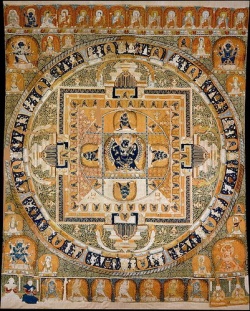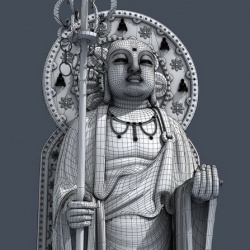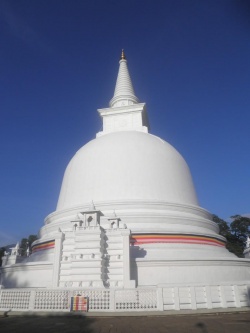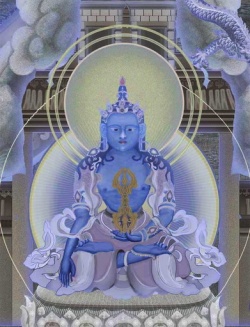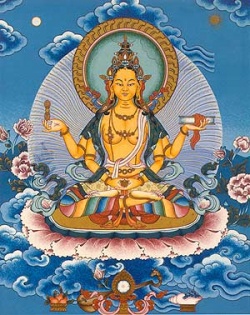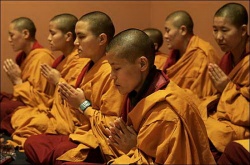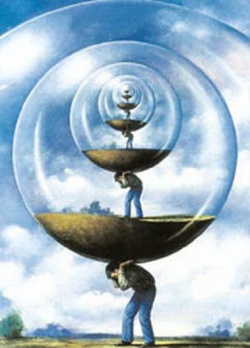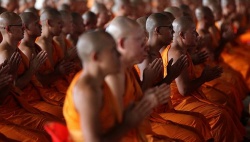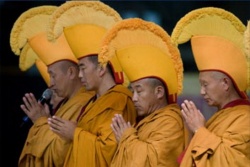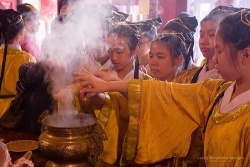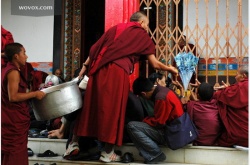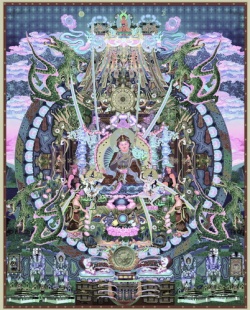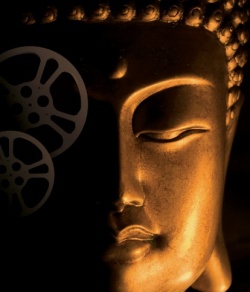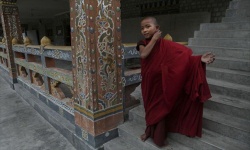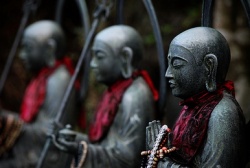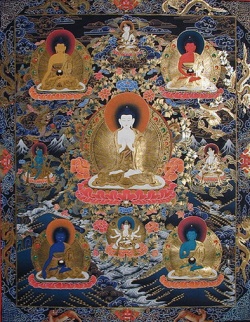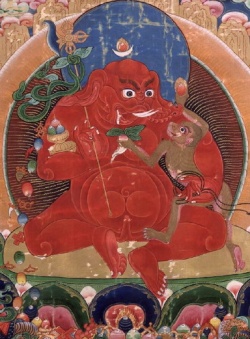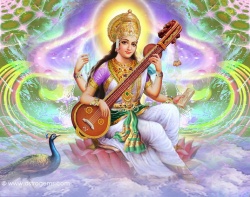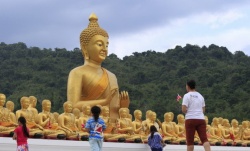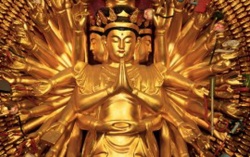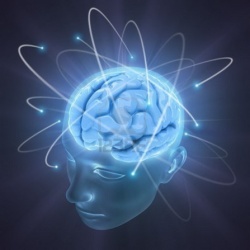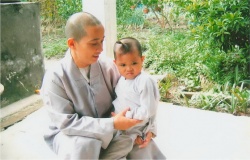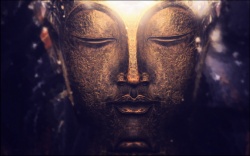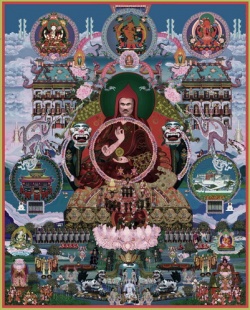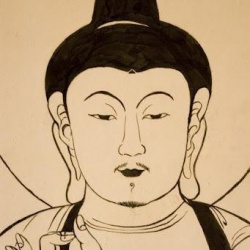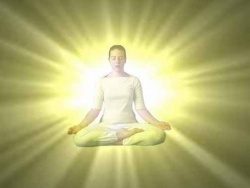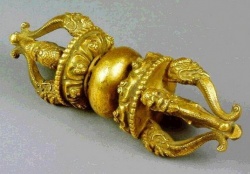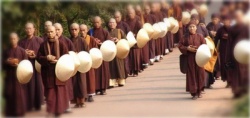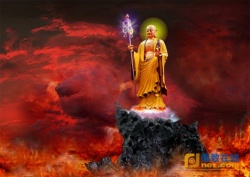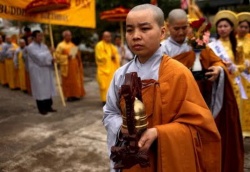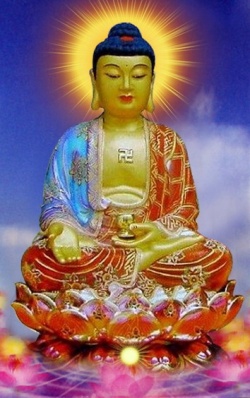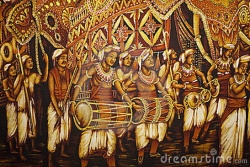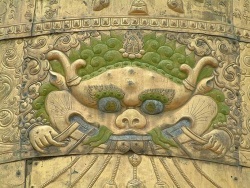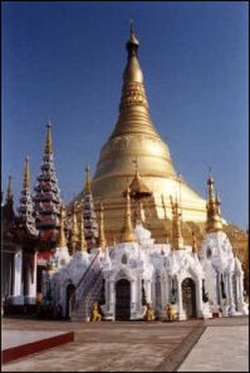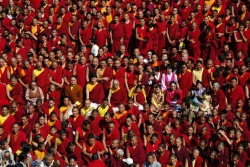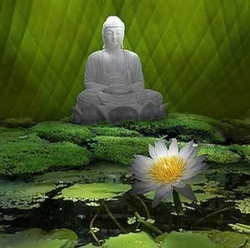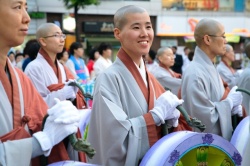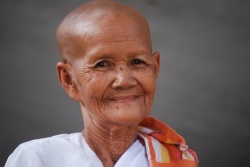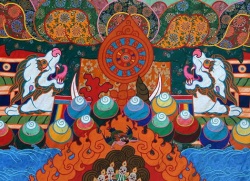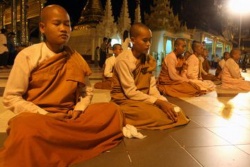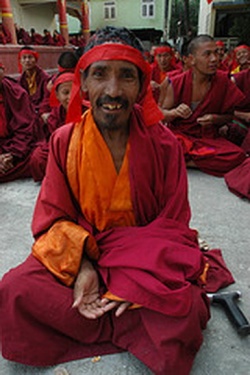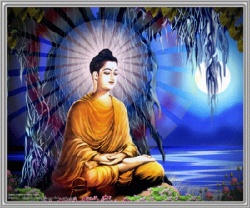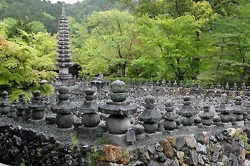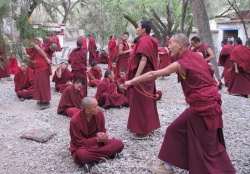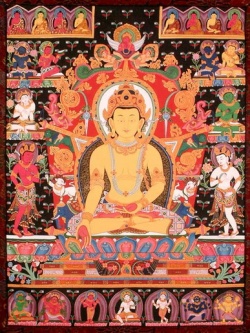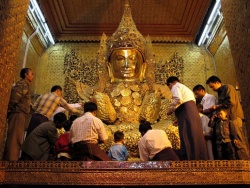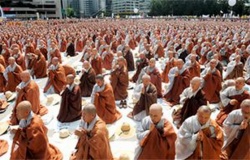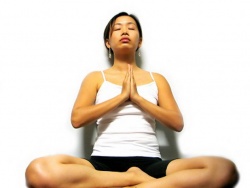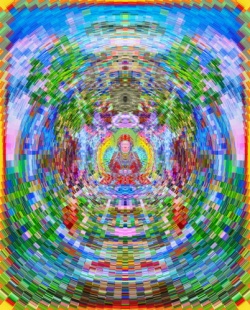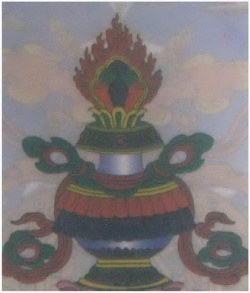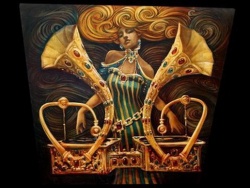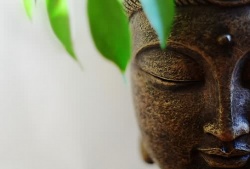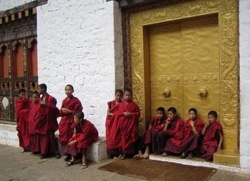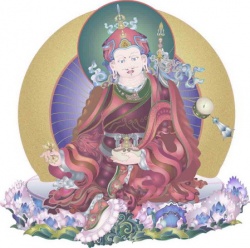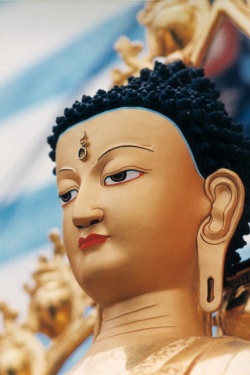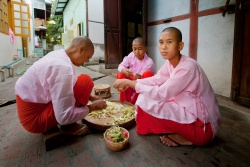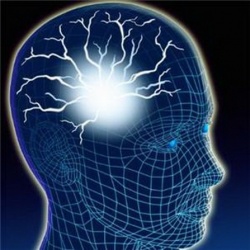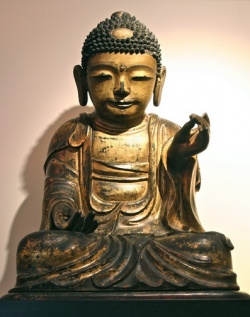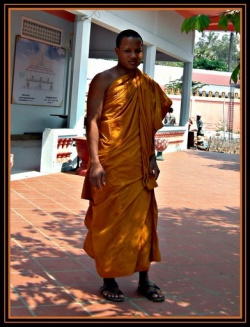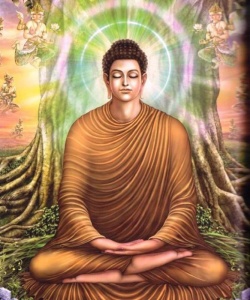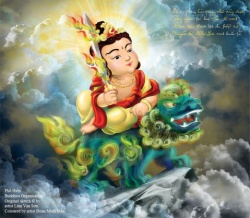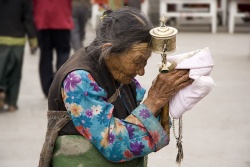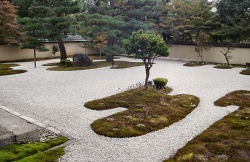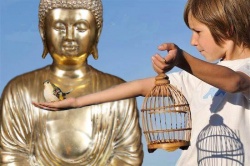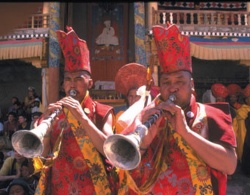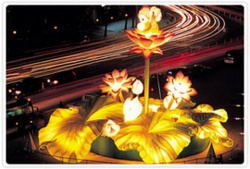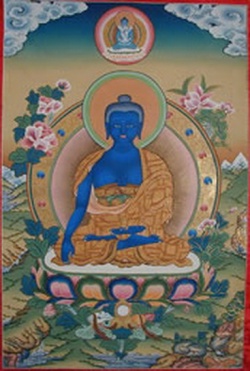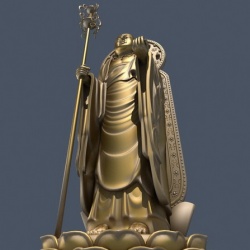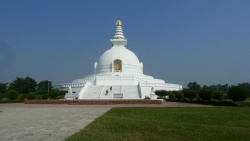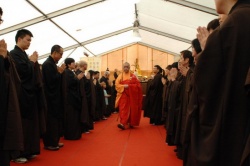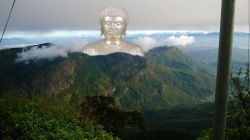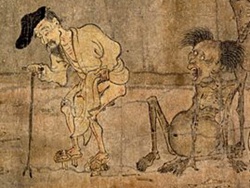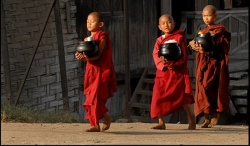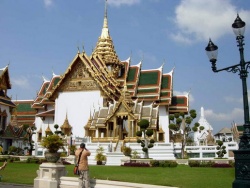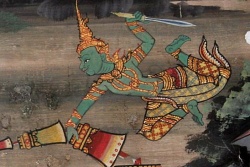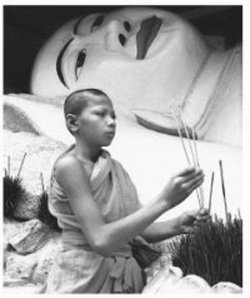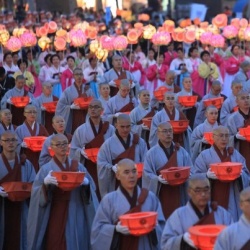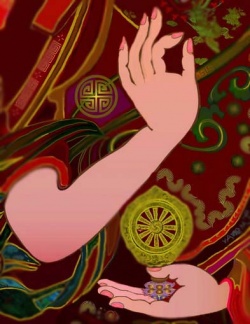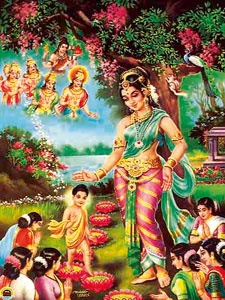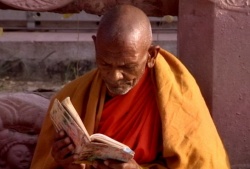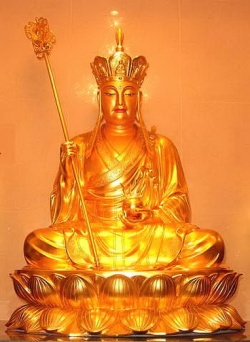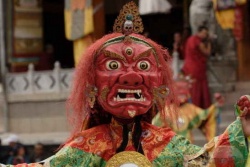398 Different uses of numbers in Buddhism
<poem>
A Bodhisattva who is one lifetime away from Buddhahood. The best known example is the Bodhisattva Maitreya.
The one Yana, the vehicle of Oneness. The one Buddhayana, the One Vehicle, i.e., Mahayana, which contains the final or complete Law of the Buddha and not merely a part, or preliminary stage, as in Hinayana.
(Jpn.: meigo-funi or meigo-ittai) Also, non-duality of delusion and enlightenment. The principle that delusion and enlightenment are, though different in aspect, one and the same in their essential nature. A bad cause or influence gives rise to delusion, and a good cause or influence, to enlightenment. Delusion and enlightenment are two different workings, but both arise from the essential nature of life. This Mahayana concept contrasts with the Hinayana view that enlightenment and delusion, or enlightenment and earthly desires, are mutually exclusive and incompatible.
- 1. the enlightenment of Devadatta (hence, evil people can become Buddhas
- 2. the enlightenment of the dragon king's daughter (hence, women can become Buddhas)
- 1. attachments which are inborn, instinctive (sahaja)
- 2. attachments which are acquired from reasoning and discrimination (vikalpita)
Dharmakaya and Rupakaya
Collections of virtue and wisdom.
Two Deaths refer to;
Views of eternalism and nihilism.
1. the absolute (silence) 2. the relative (speech)
Two Obstacles refer to
- 1 the obstacle of afflictions
- 2 the obstacle of what is known
- 1. good and evil deeds produce happiness and suffering
- 2. results return to none other than the performer of the deeds
It refers to the Sthaviravadin and Mahasanghika.
Generation Stage and Completion Stage
- 1. sudden teachings (avatamsaka sutra)
- 2. gradual teachings:
- a) the distinct teachings of the three vehicles (prajnaparamitra sutra)
- b) the pervasive teaching of the three vehicles (vimalakirti nirdesa and bramaavisecainipariprccha)
- c) the restraining and praising teaching (Perfection of Wisdom)
- d) the identical-goal teaching (Lotus Sutra)
- e) the teaching of eternal abiding (Nirvana Sutra)
Relative or conventional, everyday truth of the mundane world subject to delusion and dichotomies and
the Ultimate Truth, transcending dichotomies, as taught by the Buddhas.
According to Buddhism, there are two kinds of Truth, the Absolute and the Relative.
1. The Absolute Truth (of the Void) manifests "illumination but is always still," and this is absolutely inexplicable.
2. The Relative Truth (of the Unreal) manifests "stillness but is always illuminating," which means that it is immanent in everything. (Hsu Heng Chi/P.H. Wei). Pure Land thinkers such as the Patriarch Tao Ch'o accepted "the legitimacy of Conventional Truth as an expression of Ultimate Truth and as a vehicle to reach Ultimate Truth.
Even though all form is nonform, it is acceptable and necessary to use form within the limits of causality, because its use is an expedient means of saving others out of one's compassion for them and because, even for the unenlightened, the use of form can lead to the revelation of form as nonform" (David Chappell).
- 1. being
- 2. both being and non-being
- 3. both being and non-being and neither being nor non-being
- 1. non-being
- 2. neither being nor non-being
- 3. both not being and not non-being and neither not being nor not non-being
- 1. those who are momentarily lacking the parinirvana-dharma
- 2. those who are indefinitely so lacking
1. Buddhist disciples 2. self-enlightened sages
In the first lifetime, the practitioner engages in mundane good deeds which bring ephemeral worldly blessings (wealth, power, authority, etc.) in the second lifetime. Since power tends to corrupt, he is likely to create evil karma, resulting in retribution in the third lifetime. Thus, good deeds in the first lifetime are potential "enemies" of the third lifetime. To ensure that mundane good deeds do not become "enemies the practitioner should dedicate all merits to a transcendental goal, i.e., to become Bodhisattvas or Buddhas or, in Pure Land teaching, to achieve rebirth in the Pure Land -- a Buddha land beyond Birth and Death.
In a mundane context, these three lifetimes can be conceived of as three generations. Thus, the patriarch of a prominent family, through work and luck, amasses great power, fortune and influence (first lifetime).
His children are then able to enjoy a leisurely, and, too often, dissipated life (second lifetime). By the generation of the grandchildren, the family's fortune and good reputation have all but disappeared (third lifetime).
- 1. the true basis (real nature; Buddha nature)
- 2. basis of understanding (wisdom)
- 3. basis of conditions (practice)
- Three Baskets (of Scriptures)
(skt. Tripitaka; Pali. Tipitaka)
- 1. Vinaya-pitaka: origin of the sangha; rules for monks and nuns
- 2. Sutra-pitaka: discourses of the Buddha
- 3. Abhidharma-pitaka: writings and discourses on Buddhist psychology and philosophy
- 1. Manjushiri (wisdom)
- 2. Samantabhadra (practice)
- 3. Kuan-yin (compassion)
- 1. Dharmakaya: (body of essence; body of the Law) The Dharma-body, or the "body of reality", which is formless, unchanging, transcendental, and inconceivable. Synonymous with suchness, or emptiness.
- 2. Sambhogakaya: (body of bliss, purity) the "body of enjoyment", the celestial body of the Buddha. Personification of eternal perfection in its ultimate sense. It "resides" in the Pure Land and never manifests itself in the mundane world, but only in the celestial spheres, accompanied by enlightened Bodhisattvas.
- 3. Nirmanakaya: (body of magical transformation) the "incarnated body" of the Buddha. In order to benefit certain sentient beings, a Buddha incarnates himself into an appropriate visible body, such as that of Sakyamuni Buddha. The incarnated body of the Buddha should not be confused with a magically produced Buddha. The former is a real, tangible human body which has a definite life span, The latter is an illusory Buddha-form which is produced with miraculous powers and can be withdrawn with miraculous powers
(G.C.C. Chang).
- 1. five aggregates
- 2. twelve entrances
- 3. eighteen realms of sense
Buddha shows that a person is nothing more than a combination of various elements which come together under suitable conditions. They are
- 1 the Five Skandhas
- 2 the Twelve Bases
- 3 the Eighteen Fields
In Tien Tai, three doubts in the mind of Bodhisattva, producing three delusions, i.e.,
- 1 through things seen and thought
- 2 through the immense variety of duties in saving humans
- 3 through ignorance
Or poisons or negativities
- 1. Ignorance,
- 2. Aversion/anger
- 3. Attachment
They are the Dogma of
- 1. Void,
- 2. Unreal
- 3. Mean.
See also; Three Meditations of One Mind.
the three kinds of Enlightenment:
- 1 Enlightenment for self
- 2 Enlightenment for others
- 3 Perfect enlightenment and accomplishment
The first is Arhat. The second is Bodhisattva. When all the three have been attained, the being becomes a Buddha.
They are the three lowest realms of the Nine Realms:
- 1. Hell
- 2. Hungry ghost
- 3. Animal
- 1. being a water buffalo: fall of an ascetic
- 2. not accepting food: fall of the precious
- 3. not cutting off sound and form: fall according to kind
- 1. What contains and includes the universe?
- 2. What stops the flow of reincarnation?
- 3. What is the state of one wave follwoing another?
- 1. voidness
- 2. formlessness
- 3. inactivity
They are
- 1. Man
- 2. Asura
- 3. Deva Paths
- 1. ti: substance
- 2. hsiang: appearance
- 3. yung: function
- 1. Morality (ethics)
- 2. Concentration (meditation)
- 3. Wisdom (discriminating awareness)
- 1. the eighteen special (avenika) dharmas of the Buddha which are extremely subtle (paramasuksma)
- 2. the infinite variety of gross and subtle material aggregates (paramanusancita) that are distant in place
- 3. those that are remote in time (viprakrstakala)
(Sanskrit: Rathatraya, Also: Three Precious Ones, Three Jewels Gems, Three Jewels Refuges)
- 1. The Buddha
- 2. The dharma (truth or teachings)
- 3. The sangha (monastic community)
The three essential components of Buddhism. They are the objects of veneration. Buddhists take refuge in them by pronouncing the threefold refuge formula, thus acknowledging themselves to be Buddhists. Sometimes referred to as the Teacher, the Teaching and the Taught.
The three conditions, inheritances or karmas, of which there are several groups, including the karmas of
see; 3 Buddha Bodies
- 1. Prajna of languages
- 2. Prajna of contemplative illumination
- 3. prajna of the characteristics of actuality
- 1. recognition of ego and all dharmas as empty
- 2. recogniction of all dharmas as formless and without distinctions
- 3. recognition of existence as unworthy of desire (suffering)
Also known as Three Inconceivable Meditations, which is one of the practices in Tien Tai Sect in China. According to Tien Tai, all existence in the universe consists of Three Dogmas (Truths), namely, Void, Unreal and Mean. These three Dogmas are co-existent and interactive, integrated and interrelated. If one can meditate this concept with the whole mind, it is call Three Meditations of One mind, or Inconceivable Profound Meditation.
- 1. meditation of emptiness (sunyata)
- 2. signlessness (animitta): noncognition
- 3. wishlessness (apranihita): freedom from desire; nonattachment
- 1. the imagined (parikalpa)
- 2. the dependent (paratantra)
- 3. the perfected (parinispanna)
Also called Three Obstacles. They are the obstructions that hinder the attainment of Buddhahood. When the Three Obstructions are cleared, the Three Virtues will be perfected. The Three Obstructions are:
- 1 Affliction obstruction - e.g. due to Three Poisons, i.e. greed, hatred and stupidity.
- 2 Karma obstruction - e.g. due to Five Offenses, and Ten Unwholesome Deeds, i.e. the Karma in the past.
- 3 Retribution obstruction - e.g. the suffering retribution in Three Evil Paths
- 1. undergarment wrapped about loins and thigh (antara-vasaka)
- 2. overgarment (uttarasanga)
- 3. cloak (sanghati)
That is the
- 1. Past
- 2. Present
- 3. Future
- 1. detachment from everything
- 2. not abiding in detachment
- 3. not having any understanding of non-abiding
(non-awarness of non-duality)
- 1. seeing its intent
- 2. practical application
- 3. transcendence
- 1. rules of discipline (vinaya)
- 2. teachings of Nagarjuna
- 3. teachings of Asanga
- 1. teaching
- 2. practice
- 3. enlightenment
- 1. Craving (Greed or wrong desire)
- 2. Aversion (Hatred or anger)
- 3. Delusion (Illusion or stupidity or ignorance)
These are the source of all the passions and delusions
- 1. Renunciation
- 2. Bodhicitta
- 3. Wisdom realizing emptiness
Pure Land Buddhism is based on three basic sutras:
- 1. Amitabha Sutra (or Shorter Amitabha Sutra, or Smaller Sukhavati-Vyuha, or the Sutra of Amida)
- 2. Longer Amitabha Sutra (or Longer Sukhavati-Vyuha, or the Teaching of Infinite Life)
- 3. Meditation Sutra (or the Meditation on the Buddha of Infinite Life, or the Amitayus Dhyana Sutra). Sometimes the last chapter of the Avatamsaka Sutra ("The Practices and Vows of the Bodhisattva Samantabhadra") is considered the fourth basic sutra of the Pure Land tradition.
Note: in Pure Land, the Longer Amitabha Sutra is considered a shorter form of the Lotus Sutra.
Sanskrit word is Triloka. It is Buddhist metaphysical equivalence for the triple world of earthe and heaven.
- 1. Realm of Sensusous Desire (Sanskrit word is Kamadhatu) of sex and food. It includes the Six Heavens of Desire, the Human World and the Hells.
- 2. Realm of Form (Sanskrit word is Rupaadhatu) of matter which is substantial and resistant. It is a semi-material conception. It is above the lust world and contains bodies, places and things, all mystic and wonderful. It consists of 18 heavens, including the Heavens of Four Zen (Sanskrit word is Brahmalokas).
- 3. Realm of Formlessness (Sanskrit word is Arupadhatu) of pure spirit, where there are no bodies and matters to which human terms would apply, but where the mind dwells in mystic contemplation; its extent is indefinable, but it is conceived of in Four Stages/Places of Emptiness in the immaterial world. It has four heavens, in which the Sphere/heaven of neither-perception-nor-non-perception is the highest.
Taking refuge and possessing confidence in the
Another group is the three grades of good "roots" or abilities, i.e. superior, medium and inferior.
Levels of motivation of a practitioner: Low/initial/small scope: achievement of good Rebirth, Middle/intermediate scope: achievement of Liberation, and Highest/great scope
Also known as Three Universal Truths.
It is called the seal because it is to certify whether it is the Buddha's teaching or not. Also see Four Seals.
- 1. sealing mud: for the sort that considers something has been attained and leaves traces
- 2. sealing water: for whom something is attained but leaves no traces
- 3. sealing space: for superior ones who attain and leave no trace
They are
All three were translated by Kumarajiva, on which the Three Shastra Sect bases its doctrines.
- 1. sila: moral conduct and character
- 2. samadhi: mental concentration
- 3. panna: liberating knowledge of human existence
- 1 Sila, i.e. taking Precepts
- 2 Dhyana, i.e. concentration and meditation
- 3 Prajna, i.e. wisdom
It is practiced by the Arhats.
- 1. suffering that consists of suffering (duhkha-duhkhata)
- 2. suffering that consists in being compounded ( samskara-duhkhata)
- 3. sufferng that consists in transformation (viparinama-duhkhata)
- 1 Feeling of suffering
- 2 Feeling of happiness - suffering of decay
- 3 Feeling of neither suffering nor happiness - suffering of the activity of the Five Skandhas.
- 1. Taoism
- 2. Confusianism
- 3. Buddhism
- 1. lion throne
- 2. lotus throne
- 3. Mount Meru
- 1. Past
- 2. Present
- 3. Future
- 1. Moral discipline
- 2. Concentration
- 3. Wisdom
(the essential trainings of the Sutrayana)
- 1. the Middle Way (Chung lun; Madhyamika Sastra by Nagarjuna)
- 2. Twelve Gates (Shih-erh men lun; Dvadasanikaya Sastra by Nagarjuna)
- 3. the one hundred verses (Po lun; Sata Sastra by Aryadeva)
Actions of
- 1. Suffering of suffering (pain, distress)
- 2. Suffering of change
- 3. All-pervasive suffering (potential to suffer).
- 1. Pratimoksha
- 2. Bodhisattva
- 3. Tantric Vows
Also known as the Three Seals. Three Universal Truths are the basic teaching of Buddha, so that they are commonly used to attest Buddhism (also Three Universal Characteristics)
The Three Universal Truths are:
- 1 All phenomena are impermanent, (i.e., Anicca in Sanskrit).
- 2 All dharmas are non-self, (i.e., Anatta in Sanskrit).
- 3 The eternity is Nirvana and stillness, All sensations are suffering.
- 1. sravakayana: understanding the truth of the Buddha teachings
- 2. pratyekabuddhayana: understanding the truth through self-awakening
- 3. bodhisattvayana: understanding the highest level of wisdom (bodhi)
The three virtues of power,
- 1 the virtue, or potency of the Buddha's eternal, spiritual body, i.e., the Dharmakaya
- 2 the virtue of his Prajna, knowing all things in their reality
- 3 the virtue of his freedom from all attachments and his sovereign liberty
- 1. dharmakaya (the essence of the universe; the dharma; the law)
- 2. prajna (wisdom)
- 3. moksa (enlightenment
There are three kinds of wisdom:
- 1 Sravaka and Praetyka-Buddha knowledge that all the Dharmas or laws are void and unreal
- 2 Bodhisattva knowledge of all things in proper discrimination
- 3 Buddha knowledge or perfect knowledge of all things in their every aspect and relationship past, present and future.
In Tien Tai Sect, the Three Wisdom is associated with the Three Dogmas of Void, Unreal and Mean.
- 1. hell beings
- 2. hungry ghosts
- 3. animals
One of Buddhist cosmologies, in which the cosmos is divided into three parts
The first and last of these three represent attachment to the senses, and are undesirable. Those in the second level have a body but do not cling to the world of illusion and senses. In Zen practice the three worlds are also considered levels or dimensions of consciousness.
- 1. Keeping one's vows
- 2. Collecting virtue
- 3. Helping sentient beings
They are
- 1 Dharma body, i.e. Dharmakaya - its own essential nature, common to all Buddhas.
- 2 Retribution body, i.e. Sambhogakaya - a body of bliss, which he receives for his own use and enjoyment.
- 3 Response and transformation body, i.e. Nirmanakaya - he can appear in any form whenever and wherever necessary for the sake of crossing over others.
- 1. cessation as realizing emptiness
- 2. cessation as realizing expedient conditions
- 3. cessation as an end to both discriminatory extremes
- 1. contemplating the real (conventional reality)
- 2. contemplating the unreal (emptiness)
- 3. contemplating neither the real nor unreal; contemplating both the real and unreal (the Middle Way)
- 1. training in moral discipline (shila)
- 2. training in the mind (samadhi)
- 3. training in wisdom (prajana)
- 1. emptiness; no substantial being = supreme truth
- 2. convential, dependent co-arising phenomena = worldly truth
- 3. affirmation of emptiness and conventional truth = Middle Way
- 1. kamadhatu: realm of sensuous desire
- 2. rupadhatu: realm of form
- 3. arupadhatu: formless realm of pure spirit
In tantric practice:
- 1. Pacifying
- 2. Increasing/developing
- 3. Controlling and subjugating/terrifying
- 1. being
- 2. non-being
- 3. both being and non-being
- 4. neither being nor non-being
- 1. mindfulness of body
- 2. mindfulness of feeling
- 3. mindfulness of thoughts
- 4. mindfulness of all things
- 1. dana: giving to others; charity
- 2. priyavacana: affectionate speech
- 3. arthakrtya: conduct profitable to others
- 4. samanarthata: cooperation with others; adaptation of oneself to others
- 1. I vow to rescue the boundless living beings from suffering.
- 2. I vow to put an end to the infinite afflictions of living beings.
- 3. I vow to learn the measureless Dharma-doors.
- 4. I vow to realise the unsurpassed path of the Buddha.
12th century CE designation for four early Confucian philosophical writings; they are the
- 1. The Analects (Lun Yu)
- 2. The Great Learning (Ta Hsueh)
- 3. The Doctrine of the Mean (Chung Yung)
- 4. The Mencius (Meng-tzu).
- 1. Svabhavikakaya
- 2. Jñana-dharmakaya
- 3. Sambhogakaya
- 4. Nirmanakaya
- 1. realm where all classes dwell (Buddha, disciples, outsiders, men, etc)
- 2. temporary realm where inhabitants are free of unenlightened thoughts but will be reborn
- 3. realm of reward, for Bodhisattvas
- 4. realm of stillness and illumination, the abode of Buddhas
The class system in ancient India:
- 1 Brahman - the highest caste,
- 2 Kshatriyas (royal families) - the warrior,
- 3 Vaishyas (ordinary citizen),
- 4 Sudras (slaves)
- 1. Dhritarashtra (eastern guardian; Upholder of the Nation)
- 2. Virupaksha (western guardian; Wide-Eyed)
- 3. Vaishravana (northern guardian; Hearer of Many Teachings)
- 4. Virudhaka (southern guardian; Increase and Growth)
- 1. East, Lüpagpo, Noble-body-land
- 2. South, Dzambuling, Jambu-fruit-land (our human world)
- 3. West, Balangchö, Cattle Enjoyments
- 4. North, Dramiñän, Unpleasant Voice.
These continents appear in the Mandala offering, and are part of the symbolic representation of the entire universe.
- 1. the phenomenal realm, with differentiation
- 2. the noumenal realm, with unity
- 3. the realm of the interdependence of the phenomenal and noumenal
- 4. the realm of the phenomenal which are also interdependent
All matters are formed and are composed by four conditioned causes :
- 1. earthh is characterized by solidity and durability
- 2. water, which is characterized by liquid/fluid and moisture
- 3. fire, which is characterized by energy and warmth
- 4. wind, which is characterized by gas/air movement.
- 1. hell beings
- 2. hungry ghosts
- 3. animals
- 4. titans
- 1. illusion that there is a real self (ego) in the five skandhas
- 2. that this personality is is different from beings on other paths
- 3. that all beings have an ego born of the five skandhas
- 4. that the ego has a determined or fated period of life
There are four kinds of fearlessness, of which there are two groups:
A Buddha's fearlessness arises from
- 1 his omniscience
- 2 perfection of character
- 3 overcoming opposition
- 4 ending of suffering
B Bodhisattva's fearlessness arises from
- 1 powers of memory
- 2 power of moral diagnosis and application of the remedy
- 3 power of ratiocination
- 4 power of solving doubts
- 1. dwelling in spheres of ethereal infinity
- 2. infinity of consciousness
- 3. nothingness
- 4. neither ideation nor non ideation
Mindfulness of
Also called the "Four Fruits", the "Four Rewards", or the "Four Phala". These are four grades of arhatship, namely:
- 1 Srota-apanna (Srota-apanna in Sanskrit, Sota-panna in Pali) : has entered the stream of holy living; the first stage of the arhat, that of a Sravaka
- 2 Sakrdagamin (Sakrdagamin in Sanskrit, Sakadagamin in Pali) : comes to be born once more; the second grade of arhatship involving only one birth
- 3 Anagamin: will not be reborn in this world (i.e. Six Paths), but in the Form Realm or Formless Realm, where he will attain to Nirvana
- 4 Arhat: enters Nirvana. All Karma of reincarnation is destroyed. He also reaches a state of no longer learning. He is the highest Saint in Hinayana in contrast with the Bodhisattva as the Saint in Mahayana
- 1. stream enterer
- 2. once returner
- 3. never returner
- 4. arahat who has no more need to study
- 1. grace of parents
- 2. grace of all beings
- 3. grace of the Ruler
- 4. grace of Triratna (Buddha, Dharma, Sangha)
They represent the four major characters of Bodhisattva:
- Manjusri - Universal Great Wisdom Bodhisattva
- Samantabhadra - Universal Worthy Great Conduct Bodhisattva
- Ksitigarbha - Earth Treasury King Great Vow Bodhisattva
- Avalokitesvara - Guan Shr Yin Great Compassion Bodhisattva
All matters are formed and are composed by four conditioned causes :
- 1. earth is characterized by solidity and durability
- 2. water, which is characterized by liquid/fluid and moisture
- 3. fire, which is characterized by energy and warmth
- 4. wind, which is characterized by gas/air movement
- 1 Vow to take across the numberless living beings.
- 2 Vow to cut off the endless afflictions.
- 3 Vow to study the countless Dharma doors.
- 4 Vow to realize the supreme Buddha Way.
- 1. though the many beings are numberless, I vow to save them
- 2. though greed, hatred and ignorance rise endlessly, I vow to cut them off
- 3. though the dharma is vast and fathomless, I vow to understand it
- 4. though Buddha's way is beyond attainment, I vow to embody it fully
4 Principles that constitute the basic insights of the Buddhist path to enlightenment:
- 1. all conditioned existence is impermanent,
- 2. all deluded experiences are suffering,
- 3. all phenomena are empty and lack self-identity,
- 4.nirvana/liberation is true peace.
They are Sravaka, Praetyka-Buddha, Bodhisattva, and Buddha.
- 1. grasping the body as oneself
- 2. grasping the four gross components
- 3. grasping the five clusters
- 4. grasping the twelve sense media
Immeasurable love / loving kindness, Compassion, Equanimity, joy.
- 1. Equanimity (upekkha)
- 2. Loving-kindness (metta)
- 3. Compassion (karuna)
- 4. Sympathetic joy (mudita)
- 1. First Meditation: initial and discursive thoughts; born of aloofness; rapturous and joyful
- 2. Second Meditation: devoid of initial and discursive thoughts; born of concentration; rapturous and joyful
- 3. Third Meditation: dwelling in equanimity, attentiveness and clear consciousness; joy
- 4. Fourth Meditation: neither joy nor anguish; purification by equanimity and mindfulness, without defilements; mind becoming fixed and immovable
- 1. free from passions and evil thoughts but in possession of thought and pleasure born from discrimination
- 2. cessation of movement of thought; rapturous pleasure born of concentration
- 3. elimination of rapture but physical pleasure remains
- 4. all pleasure ceases; even-minded concentration remains
- 1. the kalpa of creation
- 2. the kalpa of continuance
- 3.the kalpa of decline
- 4. the kalpa of disintegration
- 1. constantly sitting (ch'ang-tso-san-mei)
- 2. constantly walking (ch'ang-hsing san-mei)
- 3. part walking, part sitting (pan-hsing pan-tso san-mei)
- 4. neither walking nor sitting (fei-hsing fei-tso san-mei)
- 1. free from affectation and affliction
- 2. pure conduct
- 3. accomplishment of what was to be done
- 4. free from further existence in the profane state
- 1. being (yu) = worldly truth (samvrtisatya) - non-being (wu) = real/supreme truth (paramarthasatya)
- 2. duality of being and emptiness = worldly truth (samvrtisatya) - neither being nor non-being = real/supreme truth (paramarthasatya)
- 3. affirmation and denial of being and non-being = worldly truth - transcendence of all dualities = real/supreme truth (paramarthasatya)
- 4. all three levels above = worldly truth (samvrtisatya) - beyong verbalization; beyond conceptualization = real/supreme truth (paramarthasatya)
- 1. Devaputra (actual Sentient Being called Ishvara)
- 2. Death (yama)
- 3. Defilements
- 4. Contaminated Aggregates
A mark is a notion of form. In Diamond Sutra, it states that people attach to the Four Marks which hinder them from Buddhahood. Conversely, those who see all marks as no mark are Buddhas. The Four Marks are;
- 1 a mark of self
- 2 a mark of others
- 3 a mark of sentient being
- 4 a mark of life
- 1. Compound phenomena are impermanent
- 2. Ordinary phenomena are unsatisfactory
- 3. All phenomena are insubstantial (selfless)
- 4. Nirvana is peace
- 1. being generous
- 2. speaking kindly
- 3. giving appropriate teachings
- 4. being consistent in word and deed
- 1. the two elements of matter and mind
- 2. the four gross components and the five clusters
- 3. the twelve sense media
- 4. the eighteen elements
- 1. the body (kaya)
- 2. affective sensation (vedana)
- 3. the mind (citta)
- 4. doctrinal formulas (dharma)
- 1. from the womb
- 2. from the egg
- 3. from moisture
- 4. from transformation of forms
Avoiding to respond to
- 1. anger with anger
- 2. physical harm with physical harm
- 3. criticism with criticism
- 4. verbal argumenting with verbal argumenting.
These disciplines are said to distinguish the real practitioners, as they control the causes of anger and lack of patience. (This is part of the secondary Bodhisattva vows)
It is the primary and fundamental doctrines of Shakyamuni
- 1 Doctrine of Suffering - life is suffering , suffering is a necessary attribute of sentient existence (Effect of Suffering, duhkha)
- 2 Doctrine of Accumulation - suffering comes from desire, accumulation of suffering is caused by passions (Cause of Suffering, samudaya)
- 3 Doctrine of Extinction - extinguishing desire (nirvana) ends suffering , extinction of passion (Effect of Happiness, nirodha)
- 4 Doctrine of Path - desire is extinguished through the eightfold path (or the middle way), path leading to the extinction of passion (Cause of Happiness, marga).
The first two are considered to be related to this life, and the last two to the life outside and beyond this world.
The Four Noble Truths were first preached to Shakyamuni's five former ascetic companions.
- 1. Taking refuge and generating bodhicitta
- 2. Regret / repentence
- 3. Actual positive practice (mantras, prostrations etc.)
- 4. Promise not to repeat negativities
- 1. exertion of restraint
- 2. exertion of overcoming unwholesomeness
- 3. exertion of developing wholesomeness
- 4. exertion of maintaining wholesomeness
- 1. pre-thought [not yet thinking) (wei-nien)
- 2. imminent thought [being about-to-think] (yu-nien)
- 3. the thought proper [actually thinking) (cheng-nien)
- 4. completed thought [having thought) (nien-i)
- 1. all the doctrines possessed by the Thus Come One
- 2. all the freely exercised supernatural powers of the Thus Come One
- 3. the storehouse of all the secret essentials of the Thus Come One
- 4. all the most profound matters of the Thus Come One
- 1. tuo jen pu tuo ching: take away the man but not his objective situation
- 2. tuo ching pu tuo jen: take away the objective situation but not the man
- 3. jen ching chu tuo: take away both the man and the situation
- 4. jen ching chu pu tuo: take away neither the man nor the situation
- 1. body shows land
- 2. land shows body
- 3. body and land show each other at once
- 4. no sign of body or land
- 1. identity
- 2. difference
- 3. negation
- 4. affirmation
A classification by the Pure Land and T'ien T'ai schools of the pure realms subsumed under the Land of Amitabha Buddha, as described in the sutras.They are:
- 1. the Land of Common Residence of Beings and Saints (Land Where Saints and Ordinary Beings Dwell Together), where all beings, from the six lower worlds (hells, hungry ghosts ...) to the Buddhas and Bodhisattvas, live together (further divided into two, the Common Residence Pure Land and Common Residence Impure Land)
- 2. the Land of Expediency (Land of Expedient Liberation), inhabited by Arhats and lesser Bodhisattvas
- 3. the Land of Real Reward, inhabited by the highest Bodhisattvas
- 4. the Land of Eternally Quiescent Light, in which the Buddhas dwell. These distinctions are at the phenomenal level.
At the noumenon level, there is, of course, no difference among them.
- 1. Place (environment is seen as the deity's mandala)
- 2. Body (ordinary body is imagined to be the deity's body)
- 3. Enjoyments (sense enjoyments are seen as offerings to the deity)
- 4. Action (all ones' actions are regarded as the deity's actions)
(Jpn.: shie) Buddhist teachers to be relied upon after Shakyamuni Buddha's death. They are explained in the Nirvana and other sutras, which classify them into four ranks according to their level of understanding.
The four standards of Right Dharma which buddhist should rely on or abide by:
- 1. to abide by the Dharma, not the person
- 2. to abide by the sutras of ultimate truth, not the sutras of incomplete truth
- 3. to abide by the meaning, not the word
- 4. to abide by the wisdom, not the consciousness.
The four standards of Right Dharma which buddhist should rely on or abide by:
- 1 to abide by the Dharma, not the person
- 2 to abide by the sutras of ultimate truth, not the sutras of incomplete truth
- 3 to abide by the meaning, not the word
- 4 to abide by the wisdom, not the consciousness
- 1. Human life is precious.
- 2. Death is inevitable.
- 3. The laws of karma cannot be avoided.
- 4. Suffering permeates all existence.
- 1. to assert definitely that things exist
- 2. that they do not exist
- 3. that they both exist and do not exist
- 4. that they neither exist nor do not exist
- 1. discard wrongdoings that have arisen
- 2. prevent the arising of unarisen wrongdoings
- 3. develop unarisen good actions
- 4. augment arisen good actions
- 1. Wu-t'ai-shan
- 2. P'u-t'o-shan
- 3. O-mei-shan
- 4. Chiu-hua-shan
- 1. All produced phenomena are impermanent
- 2. All contaminated products are in the nature of Suffering
- 3. All phenomena are Emptiness
- 4. Nirvana is peace.:
They are:
- 1 All phenomena are impermanent.
- 2 All Dharma are not-self.
- 3 The eternity is Nirvana.
- 4 All sensations are suffering.
From the time of Ashoka, there were four principal schools out of the Eighteen sects of Hinayana, namely
- 1. to cut off a student's thoughts
- 2. to scare away all perverted views
- 3. to see the students' reaction and discover their shortcomings
- 4. to awaken the fully aroused potentiality of students
The signs that would make Gautama seek enlightenment.
- 1. stage of limitlessness of space (akasha)
- 2. stage of limitlessness of consciousness (vijnana)
- 3. stage of nothing whatever
- 4. stage of beyond awareness and non-awareness
(Jpn.: shi-ka) Also, four stages of enlightenment or four fruits. Four levels of enlightenment that voice-hearers aim to attain, according to the Hinayana teachings.
- 1. realisation of the noble truth of suffering
- 2. one who will have but one more birth
- 3. one who will not be reborn again
- 4. arahant
- 1. the opening up of the Enlightened One's wisdom
- 2. the revelation of the Enlightened One's wisdom
- 3. the awakening to the Enlightened One's wisdom
- 4. the entry into the Enlightened One's wisdom
- 1. loving kindness to all (metta)
- 2. compassion to all (karuna)
- 3. limitless joy over the salvation of others (mudita)
- 4. limitless equanimity to friend or foe (upeksha)
- 1. Kriya-tantra (action-tantra)
- 2. Charya-tantra (performance-tantra)
- 3. Yoga-tantra
- 4. Annutarayoga-tantra (highest yoga tantra)
- 1. sudden (direct) teaching
- 2. gradual teaching
- 3. secret teaching
- 4. indeterminate teaching
4 philosophical schools, differing in their view of Emptiness:
1 & 2 are Hinayana schools, 3 & 4 are Mahayana-schools
- 1. the dharma wheel of goodness and purity
- 2. the dharma wheel of expedient means
- 3. the dharma wheel of truth
- 4. the dharma wheel without residue
The mind of Bodhisattva:
- 1. Kindness
- 2. Compassion
- 3. Delight
- 4. Renunciation
These are the cyclic process in learning a truth.
These are the cyclic process in learning a truth.
- 1. friendliness (maitri)
- 2. compassion (karuna)
- 3. sympathetic joy (mudita)
- 4. equanimity (upeksa)
- 1. Eternity or permanence
- 2. Joy
- 3. Personality
- 4. Purity.
These four important virtues are affirmed by the sutra in the transcendental or nirvana-realm.
The forms of wisdom of a Buddha.
- 1. the Great- Mirror wisdom of Aksobhya
- 2. the Universal Wisdom of Ratnaketu
- 3. the Profound Observing Wisdom of Amitabha
- 4. the Perfecting Wisdom of Amoghsiddhi.
Vows taken by bodhisattvas, that are regularly recited in zendos after zazen.
Or the Four Varga (groups) are
i.e. monks, nuns, male and female devotees.
- 1. the world of shih (events, appearance, particularity)
- 2. the world of li (reality, universality)
- 3. the world of li and shih perfectly interfused
- 4. the world of perfect mutual solution between shih and shih
- 1. pin chien chu: guest sees host
- 2. chu chien pin: host sees guest
- 3. chu chien chu: host sees host
- 4. pin chien pin: guest sees guest
- 1. one views one's mind and body as one's own possession
- 2. believing that life ends with death, or that life persists after death in some eternal and unchanging form
- 3. denial of the law of cause and effect
- 4. adhering to misconceptions and viewing them as truth, while regarding inferior views as superior
- 5. viewing erroneous practices or precepts as the correct way to enlightenment
- 1. Form, rupa: material element
- 2. Feeling, vedana: sensation
- 3. Recognition, samjna: perception
- 4. (Mental) formations, samskara: formative principal
- 5. Consciousness, vijanana: consciousness
The five fundamental conditions of the passions and delusions:
- 1 wrong view, which are common to the Trailokya
- 2 clinging or attachment in the Desire Realm
- 3 clinging or attachment in the Form Realm
- 4 clinging or attachment in the Formless Realm
- 5 the state of unenlightenment or ignorance in Trailokya, which is the root-cause of all distressful delusion.
The first five of Buddha's converts:
- 1. Ajnata-Kaundinya - Ajnata-Kondanna
- 2. Bhadrika - Bhaddiya
- 3. Asvajit - Assagi
- 4. Vaspa - Vappa
- 5. Mahanaman - Mahanama
They followed Shakyamuni to practice asceticism, but left him when he abandoned such practices. Later, when Shakyamuni attained Buddhahood, his first sermon was preached in Deer Park to these men, who became his first disciples.
Chinese Tang Dynasty Master of the Tripitaka Hsuan-Tsang established five categories of words which should be left untranslated
- 1 the esoteric
- 2 words having multiple meanings
- 3 words for things not existing in China
- 4 words not translated in accord with already established precedent
- 5 words left untranslated in order to give rise to wholesomeness and respect
In Buddhism usually the energy centers at
- 1. the brow
- 2. the crown of the head
- 3. the throat
- 4. the heart
- 5. four finger widths under the navel
12th century CE designation for five early Chinese classical texts which were purportedly compiled by Confucius; they are
- 1. The Book of Changes (I Ching)
- 2. Book of History (Shu Ching)
- 3. Book of Poetry (Shih Ching)
- 4. Record of Rites (Li Chi)
- 5. Spring and Autumn Annals (Ch'un Ch'iu).
- 1. abstain from killing
- 2. abstain from stealing
- 3. abstain from adultery
- 4. abstain from lying
- 5. abstain from intoxicating liquors
Degeneration of:
- 1. Lifetime
- 2. Era
- 3. Beings
- 4. Views
- 5. Defilements
- 1. Attachment
- 2. Anger
- 3. Ignorance
- 4. Jealousy
- 5. Doubt
(sometimes others are counted, the first 3 however are always present)
Desires connected with the five senses:
- 1. Vairochana
- 2. Akshobhya
- 3. Ratnasambhava
- 4. Amitabha
- 5. Amoghasiddhi
- 1. Amitabha
- 2. Akshobhya
- 3. Ratnasambhava
- 4. Vairochana
- 5. Amoghasiddhi
Five principal substances in Chinese thought, which are
- 1. calling the Buddha's name to attain rebirth in the Pure Land
- 2. visualizing the form of the Buddha to eradicate sins
- 3. realizing that all items of perception are mind-only
- 4. transcending both the mind and its objects of perception
- 5. the perfect understanding of nature origination
- 1. freezing the mind dhyana (ning-hsin ch'an)
- 2. subduing the mind dhyana (chih-hsin ch'an)
- 3. true essence dhyana (t'i-chen ch'an)
- 4. expedient methods for conforming to circumstances dhyana (fang-pien sui-yuan ch'an)
- 5. eliminating the distinctions of the two extremes dhyana (hsi erh-pien fen-pieh ch'an)
There are five kinds of eyes or vision
- 1 human eye: physical eyes, it is our flesh eye, an organ to see an object with limitation, for instance, in darkness, with obstruction.
- 2 divine eye: (perception of divine beings) it can see in darkness and in distance, attainable by men in dhyana (concentration/meditation).
- 3 wisdom eye: (perception of the two vehicles Sravakas and Pratyekabuddhas), the eye of Arhat and Two Vehicles i.e. the sound-hearers (Sravaka) and the Enlightened to Conditions (Praetyka-Buddha). It can see the false and empty nature of all phenomena.
- 4 Dharma eye, (perception of the bodhisattvas) the eye of Bodhisattva. It can see all the dharmas in the world and beyond the world.
- 5 Buddha eye: (perception of the Buddha), the eye of Buddha or omniscience. It can see all that four previous eyes can see.
- 1. belief in individuality (drishti)
- 2. scepticism (vichikitsa)
- 3. clinging to rites and rules
- 4. craving or desire (trishna, kama)
- 5. hatred
When the devas are dying, there are five symptoms:
- 1. the flowers around the crown
- 2. the clothes being dirty
- 3. having unpleasant smell in the body
- 4. sweating in armpit
- 5. Being unhappy in seat
- Wrong views which are common to triloka
- Clinging or attachment in the desire realm
- Clinging or attachment in the form realm:
- Clinging or attachment in the formless realm which is still mortal;
- The state of unenlightenment which is the rootcause of all distressful delusion.
- 1. the teaching
- 2. the people's capacity
- 3. the time
- 4. the country
- 5. the sequence of propagation.
- 1. Killing one's father
- 2. Killing one's mother
- 3. Killing an Arhat
- 4. Attempt to wound (draw blood from) a Buddha
- 5. Causing division amongst the Sangha.
Same as Five Hellish Sins, Five Offences
- 1. patricide
- 2. matricide
- 3. murder of an arhat
- 4. injury to a buddha
- 5. creating a schism in the sangha
Same as Five Heinous Crimes, Five Offences
- 1. desire (abhidya)
- 2. ill will (pradosha)
- 3. sloth and topor (styana and middha)
- 4. restlessness and compunction (anuddhatya and kaukritya)
- 5. doubt (vichikitsa)
- 1. Sense craving or desire (abhidya)
- 2. Anger or ill will (pradosha)
- 3. Sloth and torpor (styana and middha)
- 4. Restlessness and worry (anuddhatya and kaukritya)
- 5. Doubt and the inner critic (vichikitsa)
- 1. House of Igyo (Igyo; Kuei-yang)
- 2. House of Rinzai (Linji; Lin-chi)
- 3. House of Soto (Caodong; Ts-ao-tung)
- 4. House of Ummon (Ummon; Yun-men)
- 5. House of Hogen (Fayan; Fa-yen)
- 1. subjectivity
- 2. objectivity
- 3. non-action (from which action emerges)
- 4. interfusion of action and non-action
- 5. freedom from both action and non-action
- 1. dismissing the false, preserving the real (ch'ien-hsu ts'un-shi)
- 2. relinquishing the diffuse, retaining the pure (sh-lan liu-ch'un)
- 3. gathering in the extensions, returning to the source (she-mo kuei-pen)
- 4. suppressing the subordinate, manifesting the superior (yin-lueh shien-shen)
- 5. dismissing the phenomenal aspects, realizing the true nature (ch'ien-hsiang cheng-hsing)
- 1. meditation on the vileness of the body
- 2. meditation on compassion
- 3. meditation on dependent origination
- 4. meditation on the correct discernment of the phenomenal world
- 5. breath-counting meditation
They are five messengers of Manjusri:
- 1. hell
- 2. hungry ghosts
- 3. animals
- 4. human beings
- 5. devas
- 1. Wanshou Monastery, Mt. Jing
- 2. Lingyin Monastery, Mt. Bei
- 3. Jingde Monastery, Mt. Taibo
- 4. Jingci Monastery, Mt. Nan
- 5. Guangli Monastery, Mt. Ayuwan
The natures of
- 1. Bodhisattvas,
- 2. Sravakas and Pratyekabuddhas,
- 3. ordinary good people,
- 4. agnostics,
- 5. heretics.
The five rebellious acts or five deadly sins:
- 1. parricide, i.e., killing father
- 2. matricide, i.e., killing mother
- 3. killing an arhat
- 4. shedding the blood of a Buddha
- 5. destroying the harmony of the sangha, or fraternity.
Paths of:
- 1. Merit
- 2. Preparation
- 3. Insight
- 4. Meditation
- 5. Attainment.
The definitions of these paths differs in the Hinayana and Mahayana.
- 1. Flower Garland period (3 weeks)
- 2. Agama period (12 years)
- 3. Vaipulya period (8 years)
- 4. Wisdom period (22 years)
- 5. Lotus and Nirvana period (8 years)
- 1. the kalpa in decay, suffers deterioration giving rise to
- 2. deterioration of view, egoism arises
- 3. passions and delusions of desire, anger, stupidity, pride and doubt arise
- 4. resulting in increase in misery, decrease in happinness
- 5. span of human life gradually decreases to ten years
Arahats may have
- 1. passions
- 2. ignorance
- 3. doubt
- 4. need to recieve instructions from others and
- 5. the Path may be attained by a sudden shout
- 1. real and the seeming
- 2. body and function
- 3. principle and activity
- 4. absolute and relative
- 5. noumenon and phenomenon
- 1. Faith and confidence
- 2. Energy and effort
- 3. Mindfulness
- 4. Samadhi
- 5. Wisdom
The precepts taken by lay Buddhists:
- 1. Do not kill.
- 2. Do not steal.
- 3. Do not engage in sexual misconduct.
- 4. Do not lie.
- 5. Do not use intoxicants.
It is essential for the rebirth in human realms. See also "Ten Precepts."
- 1. the real containing the seeming
- 2. the seeming containing the real
- 3. resurgence of the real
- 4. the seeming uniting with the real
- 5. integration of the real and the seeming
- 1. particularity in universality
- 2. universality in particularity
- 3. enlightenment emerging from universality
- 4. enlightenment emerging from particularity
- 5. enlightenment achieved between universality and particularity
Traditional Confucian superior-subordinate social relationships between
- 1. father and son
- 2. elder brother and younger brother
- 3. husband and wife
- 4. elder friend and junior friend
- 5. ruler and subject.
- 1. digha-nikaya; dirghama (long discourses)
- 2. majjhima-nikaya; madhyamagama (medium discourses)
- 3. samyutta-nikaya; samyuktagama (grouped, connected discourses)
- 4. anguttara-nikaya; ekottaragama (numerical discourses)
- 5. khuddaka-nikaya; ksuddakagama (division of smaller books)
Or Five Aggregates, the five groups of elements (Dharmas) into which all existences are classified in early Buddhism, that is, the five components of an intelligent beings, or psychological analysis of the mind:
- 1. Matter or Form (rupa) - the physical form responded to the five organs of senses, i.e., eye, ear, nose, tongue and body
- 2. Sensation or Feeling (vedana) - the feeling in reception of physical things by the senses through the mind
- 3. Recognition or Conception (sanjna) - the functioning of mind in distinguishing and formulating the concept
- 4. Volition or Mental Formation (samskara) - habitual action, i.e., a conditioned response to the object of experience, whether it is good or evil, you like or dislike
- 5. Consciousness (vijnana) - the mental faculty in regard to perception, cognition and experience
- 1. the desires of the mundane world
- 2. discrimination of opposites arising from thoughtless states
- 3. idles thoughts leading to more of the same
- 4. shameful thoughts upon realization that one's previous thoughts have been idle
- 5. quietude where one is free from thoughts of desire, discrimination, idleness, shame
- 1. non-Buddhist
- 2. ordinary people
- 3. Hinayana
- 4. Mahayana
- 5. Supreme-vehicle (Bodhidharma's Zen)
- 1. desire
- 2. anger or resentment
- 3. stupidity or foolishness
- 4. arrogance
- 5. doubt
- Five Turbidities (Five Corruptions, Five Defilements, Five Depravities, Five Filths, Five Impurities)
- 1. the defilement of views, when incorrect, perverse thoughts and ideas are predominant
- 2. the defilement of passions, when all kinds of transgressions are exalted
- 3. the defilement of the human condition, when people are usually dissatisfied and unhappy
- 4. the defilement of the life-span, when the human life-span as a whole decreases
- 5. the defilement of the world-age, when war and natural disasters are rife.
These conditions, viewed from a Buddhist angle, however, can constitute aids to Enlightenment, as they may spur practitioners to more earnest cultivation.
- 1. bonpu (practice without religious motivation)
- 2. gedo (religious practice outside of Buddhist teachings)
- 3. shojo (Hinayana zen directed towards one's own inner peace)
- 4. daijo (Mahayana zen; actualization of the 'great way' of Buddhism)
- 5. saijojo (shikantaza; realization of the buddha-nature of all beings)
- 1. 7 to 9 pm
- 2. 9 to 11 pm
- 3. 11 to 1 am
- 4. 1 to 3 am
- 5. 3 to 5 am
Pancayana in Sanskrit. The Five Vehicles conveying the karma-reward which differs according to the vehicle:
- 1 Human Vehicle - rebirth among human conveyed by observing the Five Commandments (Five Precepts)
- 2 Deva Vehicle - among the devas by the Ten Forms of Good Actions (Ten Wholesomeness)
- 3 "Sound-Hearing" Arhat - among the sravakas by the Four Noble Truths
- 4 "Enlightened by Conditions" Arhat - among the pratyeka-buddhas by the Twelve Nidanas
- 5 Bodhisattva - among the Bodhisattvas by the Six Paramita
- 1. faith
- 2. mindfulness
- 3. energy
- 4. concentration
- 5. wisdom.
- 1. gnosis or dharmadhatu
- 2. mirror-like
- 3. equality
- 4. discrimination
- 5. all-accomplishing
- 1 Wisdom of the Embodied Nature of Dharma Realm - derived from amala-vijanana, i.e. pure consciousness (or mind).
- 2 Wisdom of the Great Round Mirror - derived from alaya-vijanana, (8th consciousness) reflecting all things.
- 3 Wisdom in regard to all things equally and universally - derived from manovijanana (7th consciousness).
- 4 Wisdom of profound insight, or discrimination, for exposition and doubt - destruction - derived from the mind consciousness (6th consciousness).
- 5 Wisdom of perfecting the double work of self welfare and the welfare of others - derived from the five senses (1st to 5th consciousness).
- 1. the wisdom of the essence of the phenomenal world
- 2. the great round mirror wisdom
- 3. the non-discriminating wisdom
- 4. the wisdom of insight into the particulars
- 5. the wisdom of perfect practice
Entire practice to Buddhahood based on the Mahamudra practice of the Kagyu tradition of Tibet. The 5 paths are:
- 1. Meditation On Bodhicitta
- 2. Deity Yoga
- 3. Guru Yoga
- 4. Mahamudra Practice
- 5. Dedication of Merit
Cause and effect in terms of:
- 1. object of belief
- 2. differentiation
- 3. equality
- 4. accomplishment of practice
- 5. entry of realization
- 1. above all moral conditions
- 2. tranquil and apart from false ideas
- 3. wise and omniscient
- 4. free, unlimited and unconditioned
- 5. perfect knowledge of 4 above
- 1. explanation of the title
- 2. definition of its body or substance
- 3. determining its principle
- 4. consideration of its function or applicability
- 5. ascertaining its teaching
Paramita means to cross over from this shore of births and deaths to the other shore which is the Nirvana. The Six Paramita or means of so doings are
- 1. dana - charity/giving
- 2. sila - moral/conduct/taking precepts
- 3. ksanti - patience
- 4. virya - vigor/devotion/energy
- 5. dhyana - contemplation/meditation
- 6. prajna - wisdom.
The Ten Paramita are the above plus
- 7. upaya - use of expedient or proper means
- 8. pranidhana - vow of bodhi and helpfulness
- 9. bala - strength
- 10. intelligence
- 1. Vipashyin
- 2. Shikin
- 3. Vishvabhu
- 4. Krakuchchanda
- 5. Konagamana
- 6. Kashyapa
- (7. Shakyamuni)
Usually
(Sometimes browpoint & crown are considered as one Chakra).
- 1. to propagate the Lotus Sutra widely
- 2. to copy it or cause someone else to copy it
- 3. to recite it even for a short while
- 4. to teach it even to one person
- 5. to hear of and accept it and inquire about its meaning
- 6. to maintain faith in it.
The six requirements indicating that the Sutra is a true record of teachings given directly by the Buddha. They are the fulfilment of meeting the requirement
- 1. corporal harmony (the same work)
- 2. verbal harmony (the same silence)
- 3. mental harmony (the same tolerance)
- 4. ethical harmony (the same practice)
- 5. ideological harmony (the same understanding)
- 6. material harmony (the same equality of benefits)
- 1. Puranakasyapa
- 2. Maskari-gosaliputra
- 3. Sanjaya-vairatiputra
- 4. Ajita-kesakambala
- 5. Kakuda-katyayana
- 6. Nirgrantha-jnatiputra
- 1. school of appearances as such
- 2. school of stored impressions
- 3. school of illusions
- 4. school of causal combination
- 5. school of the nonbeing of the mind
- 6. school of fundamental nonbeing
- 7. modified school of fundamental nonbeing
- 1. Naraka, as a spirit in hell
- 2. Preta, as a bodiless ghost (hungry ghost)
- 3. Tiryagyoni, as an animal
- 4. Asura, as a malevolent spirit
- 5. Manusya, as a human
- 6. Deva, as a deva i.e. Heavenly Existence
- 1. Generosity (giving)
- 2. Moral discipline (ethics)
- 3. Patience
- 4. Effort, energy
- 5. Meditative concentration
- 6. Wisdom
- 1. Bodhidharma (J. Bodaidaruma)
- 2. Hui-k'o; Dazu Huike (J. Taiso Eka)
- 3. Seng-ts'an; Jianzhi Sengcan (J. Kanchi Sosan)
- 4. Tao-hsin; Dayi Daoxin (J. Daii Doshin)
- 5. Hung-jen; Daman Hongren (J. Daiman Konin)
- 6. Hui-neng; Dajian Huineng (J. Daikan Eno)
Or Six Consciousness or Six External Bases, or Six Dusts or Six Gunas or Six Organs or Six Indriyas or Six Sense-organs or Six Sense Objects or Sadayatana. Qualities produced by the objects and organs of sense:
- 1. Eye, sight, colours and forms (caksu)
- 2. Ear, hearing, sound (srotra)
- 3. Nose, smell, scent, odours (ghrana)
- 4. Tongue, taste (jihva)
- 5. Body, touch, tangibles, phenomena (kaya)
- 6. Mind, thought, idea (dharma), (mano-vijnana)
Or Six Virtues or Six Perfections Of The Sutra On Perfect Wisdom
- 1. perfect charity (Generosity, dana)
- 2. perfect observation of the precepts (ethics, discipline) (sila)
- 3. perfect perseverance (ksanti) (patience; endurance)
- 4. perfect energy (virya) (zeal, effort and progress)
- 5. perfect meditation (concentration)
- 6. perfect wisdom (prajna)
Six periods in a day, three for day and three for night, i.e.
- 1. Morning
- 2. Noon
- 3. Evening
- 4. Night
- 5. Midnight
- 6. Dawn.
(Before meditation)
- 1. Cleaning up and setting up the altar
- 2. Make offerings on the altar
- 3. Sit comfortably, check the state of mind, taking refuge & generating bodhicitta
- 4. Visualize the merit field
- 5. Seven-limbed prayer and mandala offering
- 6. Request the guru for inspiration
- 1. determining where your mistakes lies; discriminating between good and evil
- 2. remedies for these mistakes
- 3. applying the remedies to correct the mistakes
- 4. from excessive quietude, innocence arises
- 5. quietude without consciousness leads to innocence; consciousness without quietude leads to discrimination
- 6. consciousness plus quietude leads to illumination, freeing the mind of discrimination and attachment
- 1. manifesting object within object
- 2. manifesting subject within subject
- 3. manifesting object within subject
- 4. manifesting subject within object
- 5. manifesting subject and object
- 6. manifesting object and subject within subject
- 1. the phychic power of the heavenly eye - divine sight
- 2. the psychic power of the heavenly ear - divine hearing
- 3. phychic power with regard to post lives - knowledge of all forms of previous existences of self and others
- 4. phychic power with regard to the minds- knowledge of the minds of all beings
- 5. the spiritually based psychic powers - power to appear at will in any place and to have absolute freedom
- 6. the psychic power of the extinction of outflows - insight into the ending of birth and death
Or Six Planes of Existence, See also "Evil Paths."
- 1. Hell-beings
- 2. Hungry ghosts
- 3. Animals
- 4. Humans
- 5. Asuras, anti-gods or demigods
- 6. Gods, celestials
These paths can be understood as states of mind.
Tantric meditation system, comprising the heart of the Completion Stage practice in the Kagyu school of Tibetan Buddhism
Meditation system similar to the 6 Yogas of Naropa
Set of daily tantric meditations intended to keep the daily tantric commitments
- 1. Prostration
- 2. Offering
- 3. Confession
- 4. Rejoicing
- 5. Requesting the Buddhas to remain and teach Dharma,
- 6. Dedication
(Jpn.: shichi-kakushi or shichi-bodaibun) Seven practices conducive to enlightenment. They are
- 1. Memory
- 2. Discrimination
- 3. Exertion
- 4. Joy,
- 5. Lightness and ease
- 6. Meditation
- 7. Impartiality (also referred to as indifference)
- 1. to think that one is superior to those inferior to oneself and that one is equal to one's equals
- 2. to think that one is superior to one's equals and equal to those who are superior to oneself
- 3. to think that one is superior to those superior to oneself
- 4. to be attached to the self based on the delusion that one's life is a permanent entity
- 5. to think that one has gained a truth that one has not yet perceived
- 6. to think that one is not much inferior to those who far surpass oneself
- 7. to pretend to possess virtue when one lacks virtue
- 1. three robes
- 2. one bowl
- 3. incense burner
- 4. whisk
- 5. prostration cloth
- 6. paper bedcloth
- 7. bathing articles
- 1. discerning the true and the false (dharma-pravicaya-sambodhyanga)
- 2. zeal to practice the Dharma (virya-sambodhyanga)
- 3. delight in the Dharma (pritisambodhyanga)
- 4. riddance of all coarseness and weight of body and mind ( prasra-sambodhyanga)
- 5. power of remembering dhyana and prajna (smrti-sambodhyanga)
- 6. power to realize singleness of mind (samadhi-sambodhyanga)
- 7. indifference to, renunciation of, all states (upeksa-sambodhyanga)
- 1. Gold
- 2. Silver
- 3. lapis lazuli
- 4. Crystal
- 5. Agate or Mother-of-pearl
- 6. Rubies or Red pearls
- 7. Carnelian
They represent the seven powers of
- 1. faith
- 2. perseverance
- 3. sense of shame
- 4. avoidance of wrongdoing
- 5. mindfulness
- 6. concentration
- 7. wisdom.
- 1. mountain gate (J. sanmon)
- 2. buddha hall (J. butsuden)
- 3. lecture hall (J. hatto)
- 4. latrine (J. tosu)
- 5. monks' hall (J. sodo)
- 6. bath house (J. yokushitusu)
- 7. kitchen-office (J. kuin)
- 1. great capacity and great function
- 2. swiftness of wit and eloquence
- 3. wondrous spirituality of speech
- 4. the active edge to kill or bring life
- 5. wide learning and broad experience
- 6. clarity of mirroring awareness
- 7. freedom to appear or disappear
- 1. legs in Vajra position;
- 2. hands in Meditation Mudra
- 3. back straight
- 4. eyelids half open, look to ground in front
- 5. tongue against upper pallet
- 6. shoulders straight
- 7. Mind relaxed
Possessions of a Universal Monarch (symbolizing the 7 Enlightenment factors):
- 1. Wheel (mindfulness)
- 2. Elephant (Wisdom)
- 3. Horse (Energy, Lung)
- 4. Jewel (Joy)
- 5. Queen (tranquility)
- 6. Minister (concentration)
- 7. General (equanimity).
purity in
- 1. the precepts
- 2. in heart
- 3. in views
- 4. in doubt-discrimination
- 5. in judgement
- 6. in intellection
- 7. in nirvana
- 1. hearing the Dharma
- 2. faith
- 3. discipline
- 4. meditation
- 5. zeal and devotion
- 6. abnegation
- 7. shame
Sutra titles fall into seven classes accordingly to their reference to person, Dharma and analogy.
A Three Single
- 1 Solely by reference to people, e.g. the Amitabha Sutra
- 2 Solely by reference to Dharma, e.g. the Mahaparinirvana Sutra
- 3 Solely by analogy, e.g. The Brahma Net Sutra
B Three Paired
- 4 By reference to a person and a Dharma, e.g. The Sutra of the Questions of Manjushri
- 5 By reference to a person and an analogy, e.g. The Sutra of the Lion's Roar of the Thus Come One
- 6 By reference to a Dharma and an analogy, e.g. The Wonderful Dharma Lotus Flower Sutra.
C Three-in-one
- 7 By reference to person, Dharma and analogy together, e.g. The Great Universal Buddha Flower Adornment Sutra
Eight Leisures are freedom from:
- 1-5. rebirth as hell-being, preta, animal, demi-god or god,
- 6. incomplete organs
- 7. Five Heinous Crimes
- 8. no views opposite to Three Jewels
- 1. human
- 2. organs intact
- 3. not having performed the Five Heinous Crimes
- 4. no views opposite Three Jewels
- 5. not crazy
- 6. living in land with Dharma
- 7. not living in a barbarian country
- 8. time when Dharma has appeared
- 9. Dharma teachers/centers/practitioners are around
- 10. people appreciate and help practitioners.
- 1. the future Buddha's descent from the Tusita heaven
- 2. birth on earth
- 3. leaving home
- 4. cultivating ascetic practices
- 5. conquering demons
- 6. realizing enlightenment
- 7. teaching
- 8. entering final nirvana
- 1. Umbrella
- 2. Fish
- 3. Treasure vase
- 4. Lotus
- 5. Conch
- 6. (long-life)-knot
- 7. Banner of victory
- 8. Dharma wheel
- 1. parasol (symbol of royal dignity)
- 2. two fish (symbol of the universal monarch)
- 3. conch shell (symbol of victory in battle)
- 4. lotus blossom (symbol of purity)
- 5. vase of sacred water (the nectar of immortality)
- 6. furled banner (symbol of victory of spirituality)
- 7. knot of eternity
- 8. wheel of the Dharma
(Close entourtage of Shakyamuni buddha)
- 1. Manjushri
- 2. Vajrapani
- 3. Avalokiteshvara
- 4. Kshitigarbha
- 5. Sarvanivaranaviskambini
- 6. Akashagarbha
- 7. Maitreya
- 8. Samantabhadra
- 1. Oxhead School (Niutou Farong)
- 2. East Mountain School (Dayi Daoxin & Daman Hongren)
- 3. Northern School (Yuquan Shenxiu)
- 4. Southern School (Dajian Huineng)
- 5. Sichuan School (Zizhou Zhishen)
- 6. Heze School (Heze Shenhui)
- 7. Hongzhou School (Mazu Daoyi)
- 8. Hunan School (Shitou Xiqian)
- 1. hell
- 2. realm of hungry ghosts
- 3. realm of animals
- 4. remotest districts
- 5. heaven of longevity
- 6. realm of those born before and after the Buddha
- 7. realm of those with common sense or eloquence
- 8. realm of the blind, deaf and dumb
Devas (gods) Nagas (Dragons) and others of eight divisions (classes):
- 1. liberation by examination and realization of the filthiness of all things
- 2. liberation when no subjectivie desire arises
- 3. liberation from all desires
- 4. liberation by realization of the infinity of space
- 5. liberation in realizing infinite knowledge
- 6. liberation in realizing nothingness
- 7. liberation where there is neither thought or no thought
- 8. liberation by the extinction of sensation (vedana) and conception (sanjna)
- 1. it gradually becomes deeper
- 2. being deep, its bottom is hard to fathom. Third,
- 3. its salty taste is the same everywhere
- 4. its ebb and flow follows certain rules
- 5. it contains various treasure storehouses
- 6. creatures of great size exist and dwell in it
- 7. it refuses to house corpses
- 8. it takes in all rivers and heavy rainfall without either increasing or decreasing
The eight negations of Nagarjuna, founder of Madhyamika, are actually four pairs of
- neither birth nor death
- neither end nor permanence
- neither identity nor difference
- neither coming nor going.
This is one of the important concepts of the Middle Way, the ultimate truth of Buddhism and the reality character of all Dharma.
- 1. no elimination
- 2. no production
- 3. no destruction
- 4. no eternity
- 5. no unity
- 6. no manifoldness
- 7. no arriving
- 8. no departing
They are:
- 1 no killing
- 2 no stealing
- 3 no sexual misconduct
- 4 no false speech
- 5 no alcoholic drink
- 6 no cosmetic, personal adnornments, dancing or music
- 7 no sleeping on fine beds
- 8 no eating after noon
- 1. Suffering of Birth
- 2. Suffering of Old Age
- 3. Suffering of Sickness
- 4. Suffering of Death
- 5. Suffering of being apart from the loved ones
- 6. Suffering being together with the despised ones
- 7. Suffering of not getting what one wants
- 8. Suffering of the flourishing of the Five Skandhas
Short essential text of the Kadampa Master Langri Thangpa.
Winds of Eight Directions. Most people are usually moved by the winds of the eight directions:
Desire for:
- 5. Loosing fame
- 6. Loosing worldly pleasure
- 7. Loosing material gain
- 8. When hearing harsh or unpleasant criticism towards ourselves.
Correct:
There are eighteen different characters of a Buddha as compared with all other beings in the Nine Realms.
- 1 His perfection of body (or person)
- 2 His perfection of mouth (or speech)
- 3 His perfection of memory
- 4 His perfection of impartiality to all
- 5 Serenity
- 6 Self-sacrifice
- 7 Unceasing desire to save
- 8 Unflagging zeal therein to save
- 9 Unfailing thought thereto to save
- 10 Unceasing wisdom to save
- 11 Powers of deliverance
- 12 The principle of the powers of deliverance
- 13 Revealing perfect wisdom in deed
- 14 Revealing perfect wisdom in word
- 15 Revealing perfect wisdom in thought
- 16 Perfect knowledge of the past
- 17 Perfect knowledge of the future
- 18 Perfect knowledge of the present
Or Eightfold Path or Middle Path. The way Buddha Gautama prescribed to reduce universal suffering.
- 1. Right view, beliefs (samyagdrsti)
- 2. Right intention, thought, aspirations (samyaksamkalpa)
- 3. Right speech, (samyag-vac)
- 4. Right action, conduct (samya-karmanta)
- 5. Right livelihood, (samyag-ajiva)
- 6. Right effort, zeal (samyag-vyayama)
- 7. Right mindfulness, rememberance of the right Dharma; (samyak-smrti)
- 8. Right concentration, meditation, contemplation (samyak-samadhi)
- 1. sight consciousness (chakshur-vijnana )
- 2. hearing consciousness (shrota-vijnana)
- 3. smell consciousness (ghrana-vijnana)
- 4. taste consciousness (jihvavijnana)
- 5. touch consciousness (kaya-vijnana)
- 6. mind consciousness (mano-vijnana)
- 7. mano-consciousness; 'the inner spiritual world' (mano-vijnana)
- 8. alaya consciousness; 'store-house' consciousness; the 'unconscious' (alaya-vijnana)
- 9. amala consciousness; fundamental pure consciousness (amala-vijnana)
- 1. Nagarjuna
- 2. Hui Wen
- 3. Hui Ssu
- 4. Chih Che (Chih-i)
- 5. Kuan Ting
- 6. Fa Hua
- 7. T'ien Kung
- 8. Tso Ch'i
- 9. Chan Jan
The nine realms of error, or subjection to passions, i.e. all the realms of the living except the tenth and highest, the Buddha-realm.
- the hell,
- the hungry ghost,
- the animal,
- the man,
- the Asura,
- the gods,
- the Arhat (sound hearer),
- the Arhat (enlightened to condition), and
- the Bodhisattva.
Meditation technique using 9 in- and exhalations and visualisations to calm and clear the mind:
Or Nine Grades, Classes of Lotus Flowers/Nine Classes of Lotus Flowers, i.e.
- 1. upper superior
- 2. middle superior
- 3. lower superior
- 4. upper medium
- 5. middle medium
- 6. lower medium
- 7. upper inferior
- 8. middle inferior
- 9. lower inferior
which represent ninefold future life into Pure Land. The nine grades, or rewards, of the Pure Land, corresponding to the nine grades of development in the previous life, upon which depends, in the next life, one's distance from Amitabha, the consequent aeons that are required to approach Amitabha, and whether one's lotus will open early or late.
- 1. Bodhisattvas
- 2. Pratyekas
- 3. Sravakas
- 4. devas
- 5. men
- 6. asuras
- 7. animals
- 8. hungry ghosts
- 9. denizens of hell
Helping those who are
- Suffering;
- are ignorant of Karma;
- have previously helped you;
- are in danger;
- full of grief;
- poor;
- homeless;
- already on the true Path;
- or on a wrong path
- 1. for the excellence of the sangha
- 2. for the comfort of the sangha
- 3. for the restraint of evil-minded men
- 4. for the ease of well-behaved monks
- 5. for the control of the contaminations in the here and now
- 6. for the combattng of the contaminants if future worlds
- 7. for the benefit of outsiders
- 8. for the increase in the number of insiders
- 9. for the establishing of the dhamma
- 10. for following the rules of discipline
- Ten Bhumis (stages)
stages on the path to Buddhahood:
- 1. the body of sentient beings
- 2. the body of lands
- 3. the body of rewards of action
- 4. the body of Buddhist disciples
- 5. the body of self-enlightened people
- 6. the body of enlightening beings
- 7. the body of completely enlightened ones
- 8. the body of knowledge
- 9. the body of space
- 10. the body of reality
- 1. the body of enlightenment
- 2. the body of vows
- 3. the incarnate body
- 4. the body of preservation of enlightening teachings
- 5. the body of adornment with marks of greatness
- 6. the body of powers
- 7. the body of adaptation
- 8. the body of virtues
- 9. the body of knowledge
- 10. the body of reality
- 1. shamelessness
- 2. unblushingness
- 3. envy
- 4. meanness
- 5. regretfulness
- 6. torpidity
- 7. unstableness
- 8. gloominess
- 9. anger
- 10. secret sinning
- 1. universal light
- 2. subtle light
- 3. psychic powers to travel to all lands
- 4. practice with a pure profound mind
- 5. knowing the treasury of adornments of the past
- 6. treasury of light of knowledge
- 7. knowing the adornments of Buddhas in all worlds
- 8. different bodies of all living beings
- 9. cosmic freedom
- 10. unobstructed wheel
Contemplations (meditation) on
- 1. the Enlightened One (Buddha)
- 2. the teaching (dharma)
- 3. the community (sangha)
- 4. discipline (shila)
- 5. generosity (dana)
- 6. heavenly beings (deva)
- 7. death
- 8. the body
- 9. the breath (anapanasati)
- 10. peace
also known as ten states of existence, which are
- 1 Hell
- 2 Ghost
- 3 Animal
- 4 Asura
- 5 Man
- 6 Deva
- 7 Sravaka (Sound-Hearer Arhat)
- 8 Praetyka-Buddha
- 9 Bodhisattva
- 10 Buddha
Each Dharma realm has its own characteristics, and its existence is attributed to the retribution of the beings. The lowest six realms (1-6) are known as the Six Paths or Six Realms. These six states of existence are subjected to birth and death, and then rebirth for many lives. The upper four realms are known as the Four Holy Realms. These four states of existence are beyond birth and death and liberated from the Samsara
For details, please refer to Part 2 of Buddhism In A Nutshell, which appeared in Vol. 1 No. 4 of Buddhist Door, March 1996.
- 1. north
- 2. south
- 3. east
- 4. west
- 5. northeast
- 6. southeast
- 7. northwest
- 8. southwest
- 9. up, Zenith
- 10. down, Nadir
- 1. Fa-hai
- 2. Chih-ch'eng
- 3. Fa-ta
- 4. Chih-ch'ang
- 5. Chih-t'ung
- 6. Chih-ch'e
- 7. Chih-tao
- 8. Fa-chen
- 9. Fa-ju
- 10. Shen-hui
- 1. perfect
- 2. holy one or saint
- 3. fully enlightened
- 4. gifted in knowledge
- 5. well-gone one
- 6. knower of the worlds
- 7. unsurpassable teacher of men
- 8. teacher of gods and men
- 9. awakened one
- 10. sublime one
- 1. Killing
- 2. stealing
- 3. sexual misconduct
- 4. lying
- 5. slander
- 6. coarse language
- 7. empty chatter
- 8. covetousness
- 9. angry speech
- 10. wrong views
- 1. belief in individuality (drishti)
- 2. scepticism (vichikitsa)
- 3. clinging to rites and rules
- 4. craving or desire (trishna, kama)
- 5. hatred
- 6. craving for refined corporeality
- 7. craving for incorporeality
- 8. conceit
- 9. excitability
- 10. ignorance
The Ten Forms of Good Actions for layman, or Ten Wholesomeness.
- 1 No killing
- 2 No stealing
- 3 No adultery
- 4 No lying
- 5 No slandering
- 6 No harsh speech
- 7 No idle talks
- 8 No greed
- 9 No hatred
- 10 No illusion
It is essential for the rebirth in Deva realm.
They are:
- 1 Mahakasyapa in Sanskrit, Mahakassapa in Pali. - first in ascetism.
- 2 Ananda - first in having heard the words of Buddha.
- 3 Sariputra in Sanskrit, Sariputta in Pali. - first in wisdom.
- 4 Subhuti - first in expressing emptiness.
- 5 Purna - first in explaining good law.
- 6 Maudgalyayana in Sanskrit, Moggallana in Pali. - first in supernatural power.
- 7 Katyayana - first in preaching.
- 8 Aniruddha in Sanskrit, Anuruddha in Pali. - first in the sharpness of his divine eyes.
- 9 Upali - first in taking precepts.
- 10 Rahula - first in esoteric practices and in desire for instruction in the law.
The vows of Visvabhadra Bodhisattva:
- 1 To worship and respect all Buddhas.
- 2 To praise the Thus Come One.
- 3 To practise offerings.
- 4 To repent all karmic hindrance.
- 5 To rejoice and follow merits and virtue.
- 6 To request that the Dharma wheel be turned.
- 7 To request that the Buddha remain in the world.
- 8 To follow the Buddha's teachings.
- 9 To live in accord with all living beings.
- 10 To spread all merits and virtue.
The famous vows of the Bodhisattva Samantabhadra in the Avatamsaka Sutra. These vows represent the quintessence of this Sutra and are the basis of all Mahayana practice.
Studying the vows and putting them into practice is tantamount to studying the Avatamsaka Sutra and practicing its teachings.
See also "Samantabhadra."
The Ten Meritorious Deeds allow people to gain a happy and peaceful life as well as to develop knowledge and understanding. They are:
- 1 Charity
- 2 Morality / Taking Precepts
- 3 Mental cultivation / Meditation
- 4 Reverence or respect
- 5 Services in helping others
- 6 Transference of merits
- 7 Rejoicing in the merits of others
- 8 Preaching and teaching Dharma
- 9 Listening the Dharma
- 10 Straightening one's own views
- 1. Tathagata
- 2. Arahat
- 3. Unsurpassable Enlightened One
- 4. Holder of True Knowledge and Conduct
- 5. Well-Arrived One
- 6. Knower of the World
- 7. Matchless One
- 8. Excellent Trainer
- 9. Teacher of Devas and Humans
- 10. Buddha, the World-honored One
- 1. Killing
- 2. Stealing
- 3. Sexual misconduct
- 8. Craving, covetousness
- 9. Aversion, ill-will
- 10 Delusion, wrong view
For the material there are ten kinds of offerings in Buddhism:
- 1 incense
- 2 flower
- 3 lamp
- 4 necklace
- 5 jeweled parasols
- 6 banners and canopies
- 7 clothes
- 8 fruit and food
- 9 music
- 10 joined palms
- 1. Giving or generosity
- 2. Virtue, ethics, morality
- 3. Renunciation, letting go, not grasping
- 4. Wisdom and insight
- 5. Energy, vigour, vitality, diligence
- 6. Patience or forbearance
- 7. Truthfulness
- 8. Resolution, determination, intention
- 9. Kindness, love, friendliness
- 10. Equanimity
6 Perfections plus: method, prayer, power, exalted wisdom.
The Ten Powers of Buddha or Bodhisattva are the complete knowledge of
- 1 what is right or wrong in every condition
- 2 what is the karma of every being, past, present and future
- 3 all stages of dhyana liberation and samadhi
- 4 the powers and faculties of all beings
- 5 the desires or moral directions of every being
- 6 the actual condition of every individual
- 7 the direction and consequence of all laws
- 8 all causes of mortality and of good and evil in their reality
- 9 the end of all beings and Nirvana
- 10 the destruction of all illusion of every kind
to know:
- 1. what is right and wrong in every situation
- 2. the retributive effects of past, present and future karmas of every being
- 3. all stages of dhyana liberation and samadhi
- 4. the powers and faculties of all beings
- 5. the desires or moral direction of every being
- 6. the actual condition of every being
- 7. the direction and consequences of all laws
- 8. all causes of morality and good and evil in their reality
- 9. the end of all beings and nirvana
- 10. the destruction of all illusion of every kind
- 1. not to kill
- 2. not to steal
- 3. not to commit sexual misconduct
- 4. not to lie
- 5. not to sell liquor
- 6. not to speak of the faults of lay or home-leavers
- 7. not to praise self or disparage others
- 8. not to hold back teaching or materials
- 9. not to harbour anger
- 10. not to slander the three treasures
Include an expanded version of the Five Precepts of body and mouth (not to kill, steal, engage in illicit sex, lie, or take intoxicants) with the addition of the virtues of the mind (elimination of greed, anger and delusion).
See also "Five Precepts," "Ten Evil Acts."
- 1. preparations (for self-inspection?)
- 2. adorning the sanctuary
- 3. performing obeisance
- 4. fixing one's attention (mindfulness)
- 5. preparing the willow and water
- 6. inviting the Three Jewels
- 7. reciting the dharani
- 8. exposing and confessing (sins)
- 9. doing prostrations
- 10. sitting in meditation
- 1. purity
- 2. stability
- 3. reliquishment
- 4. freedom from craving
- 5. nonregression
- 6. firmness
- 7. glowing brightness
- 8. courage
- 9. broadmindedness
- 10. magnanimity
- 1. truthfulness
- 2. flexibility
- 3. capability
- 4. control
- 5. peacefulness
- 6. pure goodness
- 7. nondefilement
- 8. nonattachment
- 9. broadmindedness
- 10. magnanimity
- 1. steadfastness
- 2. sincerity
- 3. self-respect
- 4. vigilance
- 5. seclusion from the world
- 6. contentment with little
- 7. simplicity of tastes
- 8. non-attachment
- 9. aversion of worldly activities
- 10. patience
- 1. realm of the five aggregates; the phenomenal realm
- 2. realm of blind passions
- 3. realm of illness
- 4. realm of karmic law
- 5. realm of demons
- 6. realm of meditation
- 7. realm of dogmatic views (about meditation)
- 8. realm of arrogance and pride
- 9. realm of two vehicles (rooted in negative emptiness)
- 10. realm of the bodhisattvas
- Ten Royal Virtues (for Kings)
- 1. alms-giving (dana)
- 2. morality (sila)
- 3. liberality (pariccaga)
- 4. honesty (ajjava)
- 5. mildness (maddava)
- 6. self-restricition (tapas)
- 7. Non-anger (akkodha)
- 8. non-violence (avihimsa)
- 9. patience (khanti)
- 10. non-offensiveness (avirodhana)
- 1. not to kill
- 2. not to steal
- 3. not to commit adultery
- 4. not to tell lies
- 5. not to use harsh words
- 6. not to utter words causing enmity between people
- 7. not to engage in idle talk
- 8. not to be greedy
- 9. not to be angry
- 10 not to have wrong views
- 1. Avoid the path of degredation; foster relations with virtuous people
- 2. Live in an environment that fosters spiritual practice and good character
- 3. Learn more about the Dhamma, the precepts and your own trade in depth
- 4. Take care well of your parents, spouse and children
- 5. Share time, resources and happiness with others
- 6. Cultivate virtue; avoid alcohol and gambling
- 7. Cultivate humility, gratitude and simple living
- 8. Seek opportunities to be close to monks to study the Way
- 9. Live a life based on the Four Noble Truths
- 10. Learn to meditate to end suffering
- 1 Kosa
- 2 Satyasiddhi
- 3 Madhyamika
- 4 Tien Tai
- 5 Hua Yen
- 6 Dharmalaksana
- 7 Vinaya
- 8 Chan
- 9 Esoteric
- 10 Pure Land
- 1. sudden enlightenment (sun-wu)
- 2. resolving to attain enlightenment (fa-hsin)
- 3. cultivating the five practices (hsiu wu-hsing)
- 4. spiritual development (k'ai-fa)
- 5. emptiness of self (wu-k'ung)
- 6. emptiness of dharma (fa-k'ung)
- 7. mastery of form (se-tzu-tsai)
- 8. mastery of mind (hsin-tzu-tsai)
- 9. freedom from thought (li-nien)
- 10. attainment of Buddhahood (ch'eng-fo)
Or Ten Stages Of Bodhisatttvahood ; Ten Stages Of A Bodhisattvas Progress. These are the ten stages of development of Bodhisattva depending on their merits and virtues:
- 1 Pramudita (joy) - joy at having overcome the difficulties and sufferings, now entering on the path to Buddhahood
- 2 Vimala (purity) - freedom from all possible defilement
- 3 Prabhakari (enlightenment) - stage of further enlightenment
- 4 Arcismati (widsom) - stage of glowing wisdom
- 5 Sudurjaya (no difficulty) - stage of mastering the utmost difficulties
- 6 Abhimukhi (open way, presence) - the open way of wisdom above definitions of impurity and purity
- 7 Duramgama (proceeding afar, travelling afar) - getting above ideas of self in order to save others
- 8 Acala (unperturbed) - attainment of being unperturbed
- 9 Sadhumati (discriminatory wisdom, perfect intellect) - the finest discriminatory wisdom, knowing where and how to save, and possessing the Ten Powers
- 10 Dharma megha (law cloud, clouds of truth) - attainment of the fertilizing powers of law cloud
- 1. dry wisdom stage
- 2. embryo stage of the nature of Buddha truth
- 3. stage of eight patient endurancess
- 4. freedom from wrong views
- 5. freedom from six of the nine delusions in practice
- 6. freedom from the remaining three
- 7. complete discrimination in regard to wrong views and thoughts
- 8. pratyekabuddhahood
- 9. bodhisattvahood
- 10. Buddhahood
- 1. Generosity
- 2. Moral discipline
- 3. Patience
- 4. Effort
- 5. Meditative concentration
- 6. Wisdom
- 7. Renunciation
- 8. Truthfulness
- 9. Loving-kindness
- 10. Equanimity
Represent the characteristics of Buddha
- 1 Tathagata - the Thus Come Ones
- 2 Arhat - worthy of offerings
- 3 Samyak-sambuddha - of proper and universal knowledge
- 4 Vidyacarna-sampauna - perfect in understanding and conduct
- 5 Sugata - skilful in leaving the world through liberation
- 6 Lokavid - perfect and complete understanding of all worldly Dharma
- 7 Anuttara - unsurpassed knights
- 8 Purusa-damya-sarathi - taming heroes
- 9 Sasta deramanusyanam - teachers of gods and people
- 10 Buddha-lokanatha or Bhagaran - Buddha, the World Honored Ones
Vehicles is the means to take living beings across from suffering to Nirvana. Though there are ten vehicles, there is only one teaching (Dharma), i.e., Inconceivable Virtues of the Self-mind, and the other nine are supplementary. According to Tien Tai Sect, the ten vehicles are:
- 1 Meditation of Inconceivable Virtue of the Self-mind - highest order for superior roots
- 2 Meditation of Real Bodhicitta
- 3 Meditation of Expedient Dwelling of Mind
- 4 Meditation of Breaking Universal Dharma
- 5 Meditation of Penetrating through Obstructed Consciousness
- 6 Meditation of Commissioning all Chapters of Paths
- 7 Meditation of Confronting Delusion and Advocating Enlightenment
- 8 Meditation of Understanding the Stages of Fruition
- 9 Meditation of Calmness and Endurance
- 10 Meditation of Non-attachment of Dharma
These are eleven good Dharmas of the fifty one Dharmas belonging to the heart.
- 1 faith
- 2 shame
- 3 remorse
- 4 absence of greed
- 5 absence of hatred
- 6 absence of stupidity
- 7 vigor
- 8 transquility
- 9 non-laxity
- 10 non-harming
- 11 renunciation
- 1. Ignorance
- 2. compositional factors causing misperception
- 3. consciousness
- 4. name and form
- 5. the six senses
- 6. contact
- 7. feeling
- 8. craving
- 9. grasping
- 10. becoming
- 11. (re-)birth, aging & death
The Six Internal Bases and the Six External Bases are together called the Twelve Bases. Base implies the meaning of germinating and nourishing. All mental activities are germinated and nourished from these Twelve Bases.
Twelve Divisions (of Mahayana)
- 1. sutra (prose discourses)
- 2. geya (verses which repeat the substance of the sutras)
- 3. gatha (verses of ideas not contained in the sutras)
- 4. nidana (historical narratives)
- 5. itivrittaka (past lives of the disciples of the Buddha)
- 6. jataka (past lives of the Buddha)
- 7. adbhutadharma (tales of the Buddha's miracles)
- 8. avadana (allegories)
- 9. upadesa (discussions of the doctrine)
- 10. udana (statements by the Buddha not in reply to questions)
- 11. vaipulya (sutras on broad subjects)
- 12. vyakarana (prophecies of the Buddha regarding enlightement of his disciples)
- 1. Ignorance
- 2. (Mental) formations
- 3. Consciousness
- 4. Name and form
- 5. Six Senses
- 6. Contact
- 7. Feeling
- 8. Craving
- 9. Grasping
- 10 Becoming
- 11. Birth
- 12. Aging and death
the six sense organs or facilities, including cognition
their six associated data fields
- 1. avidya (ignorance)
- 2. samskara (volition = karman)
- 3. vijnana (consciousness)
- 4. nama-rupa (name-form)
- 5. sadayatana (six organs)
- 6. sparsa (contact)
- 7. vedana (feelings)
- 8. trsna (desire)
- 9. upadana (attachment)
- 10. bhava (existence = karman)
- 11. jati (birth)
- 12. jara-marana (old age and death)
- 1. three fetters (samyojana)
- 2. three unvirtuous roots (akusalamula)
- 3. three fluxes (asrava)
- 4. four floods (ogha)
- 5. four connections (yoga)
- 6. four attachments (grahana)
- 7. four ties to the body (kayagrantha)
- 8. five hindrances (nivarana)
- 9. five fetters (samyojana)
- 10. five fetters of the lower realms (avarabhagiyasamyojana)
- 11. five fetters of the upper realms (urdhvabhagiyasamyojana) (see Ten Fetters)
- 12. five views (drsti)
- 13. six desires (kamakaya)
- 14. seven contaminants (anusaya)
- 15. nine fetters (samyojana)
- 16. ninety-eight contaminants (anusaya)
Explanation of Emptiness on the basis of categorising 16 types of phenomena:
There are eight hearts within the Desire Realm:
- 1 Patience regarding the Dharma involved in Suffering
- 2 Wisdom regarding the Dharma involved in Suffering
- 3 Patience regarding the Dharma involving in Accumulation
- 4 Wisdom regarding the Dharma involved in Accumulation
- 5 Patience regarding the Dharma involved in Extinction
- 6 Wisdom regarding the Dharma involved in Extinction
- 7 Patience regarding the Dharma involved in Way
- 8 Wisdom regarding the Dharma involved in Way
Note that the Truths of Suffering, Accumulation, Extinction and Way are the Four Noble Truths, which is the fundamental doctrine in Buddhism, particularly Hinayana.
There are the other eight hearts within the Form Realm and the Formless Realm:
- 1 Subsequent Patience regarding Suffering
- 2 Subsequent Wisdom regarding Suffering
- 3 Subsequent Patience regarding Accumulation
- 4 Subsequent Wisdom regarding Accumulation
- 5 Subsequent Patience regarding Extinction
- 6 Subsequent Wisdom regarding Extinction
- 7 Subsequent Patience regarding Way
- 8 Subsequent Wisdom regarding Way
- 1. the six sense organs
- 2. their objects
- 3. their perceptions
The Six Consciousness and the Twelve Bases are together called the Eighteen Fields.
I Mahasanghikah is divided into eight schools:
- 1 Ekavyavaharikah
- 2 Lokottaravadinah
- 3 Kaukkutikah (Gokulika)
- 4 Bahusrutiyah
- 5 Prajnativadinah
- 6 Jetavaniyah (Caityasailah)
- 7 Avarasailah
- 8 Uttarasailah
II Sthavirah or Aryasthavirah is divided into ten schools:
- 1 Haimavatah
- 2 Vatsiputriyah (developed from Sarvastivadah)
- 3 Dharmottariyah (developed from Vatsiputriyah)
- 4 Bhadrayaniyah (developed from Vatsiputriyah)
- 5 Sammatiyah (developed from Vatsiputriyah)
- 6 Sannagarikah (developed from Vatsiputriyah)
- 7 Mahisasakah
- 8 Dharmaguptah (developed from Mahisasakah)
- 9 Kasyapiyah (developed from Sarvastivadah)
- 10 Sautrantika (developed from Sarvastivadah)
Under (I), the first five are stated as arising two centuries after the Nirvana of Shakyamuni, and the remaining three a century later, dates which are unreliable.
Under (II), the Haimavatah and the Sarvastivadah are dated some 200 years after Nirvana; from the Sarvastivadah soon arose the Vatsiputriyah, from whom soon arose the third, fourth, fifth and sixth; then from the Sarvastivadah there arose the seventh which gave rise to the eighth, and again, near the 400th year, the Sarvastivadah gave rise to the ninth and soon after the tenth.
In the list of eighteen, the Sarvastivadah was not taken into account, as it split into all the rest.
- 1. asking for instruction
- 2. presenting one's understanding
- 3. investigating and discerning
- 4. meeting of minds
- 5. wrapping up (focusing)
- 6. mental activity
- 7. seeking out
- 8. not understanding
- 9. lifting up
- 10. posing a question
- 11. intentional question
- 12. using things/events
- 13. real question
- 14. fabricated question
- 15. making sure
- 16. eliciting
- 17. clarifying
- 18. silent question
- 1. the incorrect and the correct
- 2. ignorance and wisdom
- 3. stupidity and knowledge
- 4. confusion and samadhi
- 5. following the precepts and not following them
- 6. straight and crooked
- 7. real and unreal
- 8. steep and level
- 9. passions and enlightenment
- 10. compassion and harm
- 11. joy and anger
- 12. giving and begrudging
- 13. progressing and retrogressing
- 14. birth and destruction
- 15. permanence and impermanence
- 16. the Dharmakaya and the physical body
- 17. the Nirmanakaya and the Sambohogakaya
- 18. substance and function
- 19. nature and characteristics
- (20. sentience and insentience)
See the Eighteen Sects of Hinayana, plus the two originals, i.e. Mahasanghikah and Sthavirah called the Twenty Sects of Hinayana.
- 1. Mahakashyapa
- 2. Ananda
- 3. Shanavasin
- 4. Upagupta
- 5. Dhitika
- 6. Mishaka
- 7. Vasumitra
- 8. Buddhanandi
- 9. Buddhamitra
- 10. Parshva
- 11. Punyayasha
- 12. Anabodhi
- 13. Kapimala
- 14. Nagarjuna
- 15. Kanadeva
- 16. Rahulabhadra
- 17. Samghanandi
- 18. Samghayathata
- 19. Kumaralata
- 20. Shayata
- 21. Vasubandhu
- 22. Manorata
- 23. Haklenayasha
- 24. Simhabodhi
- 25. Bashashita
- 26. Punyamitra
- 27. Prajnadhara
- 28. Bodhidharma
- 1. level feet
- 2. sign of the thousand-spoked wheel on the soles of the feet
- 3. long, slender fingers
- 4. broad heels
- 5. curved toes and fingers
- 6. soft, smooth hands and feet
- 7. arched feet
- 8. lower body like an antelope's
- 9. arms reaching to the knees
- 10. virile member without narrowing in the foreskin
- 11. powerful body
- 12. hairy body
- 13. thick, curly body hair
- 14. golden-hued body
- 15. body that gives off rays ten feet in every direction
- 16. soft skin
- 17. rounded hands,shoulders and head
- 18. well-formed shoulders
- 19. upper body like a lion's
- 20. erect body
- 21. powerful, muscular shoulders
- 22. forty teeth
- 23. even teeth
- 24. white teeth
- 25. gums like a lion's
- 26. saliva that improves
- the taste of all foods
- 27. broad tongue
- 28. voice like Brahma's
- 29. clear blue eyes
- 30. eyelashes like a bull's
- 31. lock of hair between the eyebrows
- 32. cone-shaped elevation on the crown of the head
These are the physical marks of a Buddha
- 1. Level feet
- 2. thousand-spoke wheel-sign on feet
- 3. long slender fingers
- 4. pliant hands and feet
- 5. toes and fingers finely webbed
- 6. full-sized heels
- 7. arched insteps
- 8. thigh like a royal stag
- 9. hands reaching below the knees
- 10. well-retracted male organ
- 11. height and stretch of arms equal
- 12. every hair-root dark coloured
- 13. body hair graceful and curly
- 14. golden-hued body
- 15. a ten-foot halo around him
- 16. soft smooth skin
- 17. two soles, two palms, two shoulders and crown well rounded
- 18. below the armpits well-filled
- 19. lion-shaped body
- 20. erect
- 21. full shoulders
- 22. forty teeth
- 23. teeth white even and close
- 24. the four canine teeth pure white
- 25. lion-jawed
- 26. salvia improving the taste of all food
- 27. tongue long and broad
- 28. voice deep and resonant
- 29. eye deep blue
- 30. eye lashes like a royal bull
- 31. a white urna or curl between the eyebrows emitting light
- 32. an usnisa or fleshy protuberance on the crown.
Thirtyfive Buddhas associated with a specific confession/purification practice, usually combining recitation and prostrations:
- Shakyamuni
- Vajragarbhapramardin
- Ratnarchis
- Nageshvararaja
- Viresena
- Viranandin
- Ratnagni
- Ratnachandraprabha
- Amoghadarshin
- Ratnachandra
- Vimala
- Shuradatta
- Brahman
- Brahmadatta
- Varuna
- Varunadeva
- Bharadrashri
- Chandashri
- Anantaujas
- Prabhasashri
- Ashokashri
- Narayana
- Kusumashri
- Brahmajyotirvikriditabhijna
- Padmamajyotirvikriditabhijna
- Dhanashri
- Smritishri
- Suparikirtitanamashri
- Indraketudhvajaraja
- Suvikrantashri
- Yuddhajaya
- Vikrantagamishri
- Samantavabhasavyuhashri
- Ratnapadmavikramin
- Shailendraraja
These are:
- the four mindfulnesses
- the four right efforts
- the four bases of miraculous powers
- the five roots; e. the five powers
- the seven factors of enlightenment; and
- the eightfold noble path
(G.C.C. Chang).
Sequential aspects of the path to enlightenment, although found in the Mahayana traditions, most commonly present in the Hinayana schools
Set of practices which embrace all aspects of the Bodhisattva's path to enlightenment. Based on a text by Tibetan Ngulchu Thogme Zangpo
Important text by Ashvagosha which describes the proper attitude towards one's tantric Master
(Jpn.: gojuni-i) Also, fifty-two stages of practice. The stages through which bodhisattvas advance from the time of their initial resolve until they finally attain Buddhahood. The fifty-two stages are enumerated in the Jeweled Necklace Sutra and consist of
- ten stages of faith,
- ten stages of security,
- ten stages of practice,
- ten stages of devotion,
- ten stages of development,
- the stage of near-perfect enlightenment, and
- the stage of perfect enlightenment.
The Brahma Net Sutra divides Bodhisattva practice into forty stages. The Benevolent Kings Sutra divides it into fifty-one stages, and there is an explanation elsewhere that sets forth forty-one stages.
